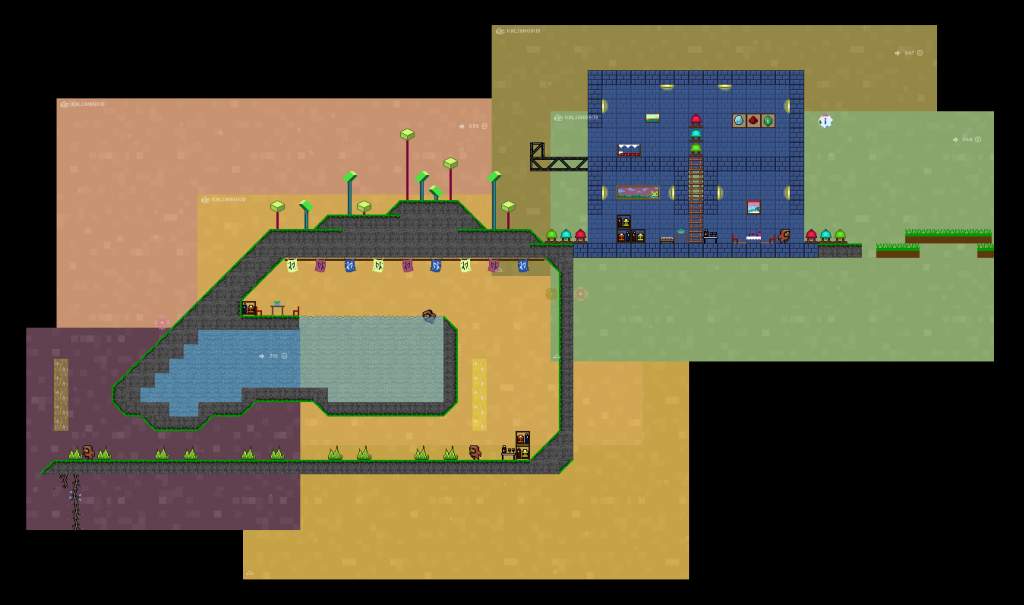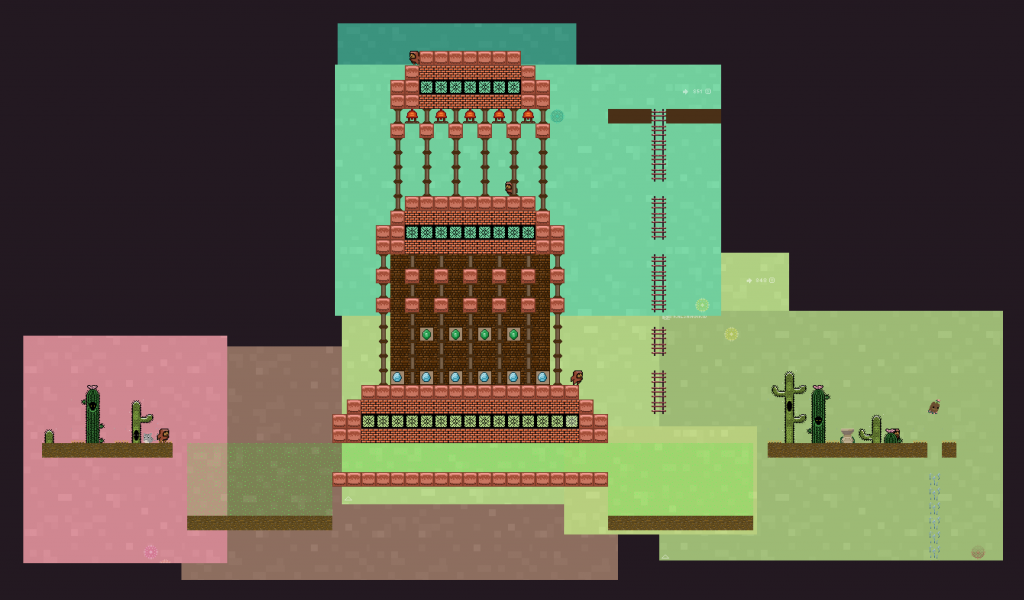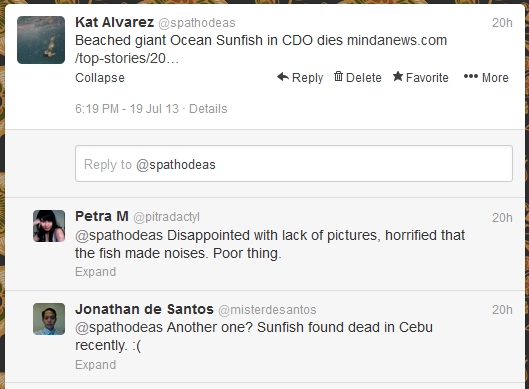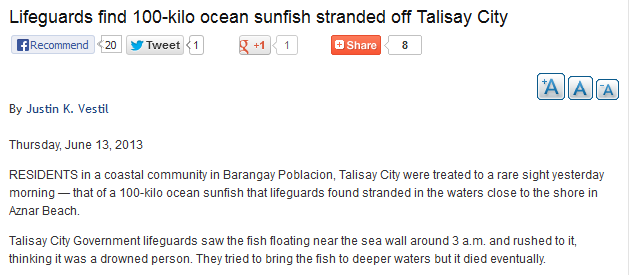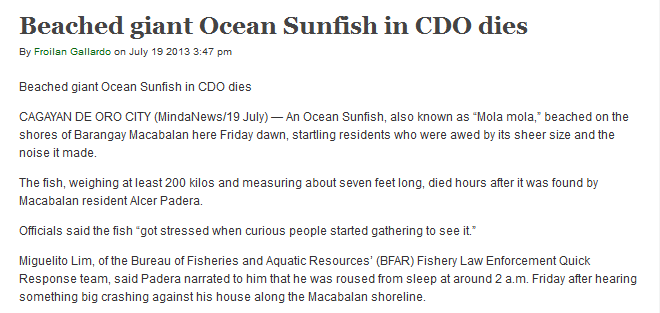Though being with Cris last year had healed me up in a way I hadn’t even imagined possible, this year, I found that there was still more healing to do. As I went on with life and went on enjoying things as they came, it seemed that, out of nowhere, some thought of the recent past would show up and deflate things.
I found myself in these weird mental cycles:
I’m having so much fun; why do I have to think of this thing now and ruin it?
Maybe thinking that this thought is ruining it is actually what is ruining it.
I’m having so much fun; why do I have to think like this and ruin it?
I kept wondering if I was unnecessarily reopening wounds that had just mended or only realizing that they were actually much deeper than I’d thought. I spent a lot of time inside my head — and, eventually, a lot less time blogging and crafting — to work these questions out.
Is processing this again doing more harm to you than good? Is there something about this that you have yet to come to terms with, or are you just rehashing the past and not letting yourself move on? What scars must you allow; how much of this are you willing to acknowledge and embrace as part of who you are now?
I found myself disappearing into music in a way I hadn’t in a long time. Sometime toward the end of the first quarter, I listened to “Fleet Foxes” for the first time, and something about the repetition and macabre implications of “White Winter Hymnal” drew me in. Eventually, the whole album awakened in me a longing for the California of my childhood.
I wanted to feel the heat of the spring sun among the endless rows of peach blossoms along the dusty county back roads. How boring I found those drives then; I couldn’t imagine why my parents wanted to just drive around to look at the same pink and white flowers over and over again, and I can still hear myself whining from the backseat. Now, I just have this memory filtered through a cranky squint. What I’d give today for all those trees.
I wanted all of it back — all those mountains and all that valley and all that coastline viewed from the backseat of a car on the freeway. How magical frost on the lawn in the early winter mornings was. How weird to see Hale-Bopp in the sky. How wet I was surprised to learn snow was, and how cold that side of the Pacific Ocean. How country music sounded on the radio. How public school construction paper and playground wood chips smelled. How tall the redwoods and the sequoias were. How it felt to make and eat my first roasted marshmallow on a twig, one night at that camp just south of Yosemite, and then to walk back to the cabins with the older kids, under the trees in the near dark.
I think California returned to me because I didn’t want to recall more recent memories that I’d already gone through and over-thought already. I didn’t want to process California, either; I just wanted to be there, somewhere faraway but familiar, and not to revisit my childhood but to make sense of my adulthood.
It felt weird to try to write or talk about these memories and these feelings while very much surrounded with stories of things going on today, in this country, where there are only two seasons. So, I just let music take me where I couldn’t physically go.
(Shoutout to Petra Magno, whose postcards from California came right in the middle of this.)
--
Here’s a list of the albums (plus one EP and some sessions) I discovered this year, with some of my favorite songs. The list is arranged in the order I first heard them, and I tried to find links to the same versions I listened to. I’m just sharing, of course; you don’t have to listen to all of them.
1. “Fleet Foxes” by Fleet Foxes
- “White Winter Hymnal”
- “Tiger Mountain Peasant Song”
2. “Through the Deep Dark Valley”, by The Oh Hellos
- “Like the Dawn”
- “Wishing Well”
- “In Memoriam”
3. “Ys”, by Joanna Newsom
- “Emily”
- “Cosmia”
— I love all five songs on “Ys”, really; these are just the first and last on the album.
4. “Helplessness Blues”, by Fleet Foxes
- “Montezuma”
- “Helplessness Blues”
5. “Get Noisey EP”, by Lucius
- “Go Home (Live)"
- “How Loud Your Heart Gets” (Live)
6. “Born to Die”, by Lana Del Rey
- “Blue Jeans”
- “Summertime Sadness”
- “This is What Makes Us Girls”
— Lana Del Rey doesn’t seem to belong on this list, but “Born to Die” was an interesting break. It made me think of how I might have turned out if my family had never left California.
7. “Honey I’m Home”, by Lucius (The Wild Honey Pie recording)
- “Two of Us on the Run”
8. “Buzzsessions”, by Lucius (The Wild Honey Pie recording)
- “It Doesn’t Matter Anymore” (Buddy Holly cover)
--
Eventually, I found my own words to explain to myself what was happening. I feel like new.
I also feel too old for some of my anxieties. When they came to me this year, I felt a mix of exasperation and despair — this problem is so x years ago; have I really progressed only this much in x years? Closure is one thing; recognizing that the door is, in fact, closed is another. That was another reason I didn’t talk about some of these things with anyone, not even Cris. I wanted to show myself that I could work things out on my own and learn, on my own, to let them go.
I finally feel now that I’m able to leave certain things to gather dust in my mental museum, visited only occasionally and — finally — painlessly. Those eras are ended. The mammals have moved in. Whatever pains from the past left still living are isolated on a tropical island somewhere. If I find myself on their shores, if I see them again, I will see them only as shrunken shadows of the species that once threatened to crush me with their great weight.
Just last month, I got my hands on two more albums, I guess to ease the way out of the woods, into the new year, and into whatever life gives me next. “Pure Heroine” took me back to high school and brought back some old insecurities, but Lorde’s own jadedness helped me to put those to rest, too. After that, “Originator” was a nice reminder that I’d managed to get through everything I’ve just written about, and there’s still plenty of and to love.
+ “Pure Heroine”, by Lorde
- “Tennis Court”
- “Still Sane”
+ “Originator”, by Brooke Waggoner
- “Waterlogged”
- “To Love”
Between the day I started working on this blog entry and today, a lot of things happened to make at least 2014 clearer. Cris got a scholarship to grad school abroad. He got the letter just last week; if everything falls into place, he might be gone next month, and I might not get to see him for several months after that.
My brother Mikko, who is not coming home for Christmas, and Camille, his girlfriend of four years, broke up this week after deciding that their lives were going in different directions.
Two acquaintances died of aneurysms this week, roughly within a day of each other. One was a bubbly, well-loved 24-year-old young woman I'd met in college. She died in a foreign country, among friends but away from family.
The other person was my grandmother's best friend. My grandmother doesn't know now if she should come home from the US to say goodbye or stay with her son, who is still fighting cancer.
It doesn't seem like a good time to be far away from anyone you love; suddenly, every day away from anyone who really matters feels like a risk. After this year, though, I find it easier to accept that this risk is a part of the life I've chosen and a part of working toward the future I hope for — the future I have to have at least a little faith in if I want to keep going at all.
15 December 2013
19 November 2013
To love [th]is life
I played this song three times last night before I went to sleep, and I started crying in the middle of the second round.
Cris turned 30 last week. I'm can't tell you just how happy and grateful I am that he was born.
05 November 2013
Forest for the trees
If I were a character in a sci-fi story, then I'd like that story to be set in the universe of the Hitchhiker's Guide to the Galaxy, so I could be a Magrathean.
The Magratheans are a bunch of specialists who custom-build planets for ridiculously rich people in the world of H2G2. One of my favorite characters in the series is a Magrathean; his name is Slartibartfast, and he designs coastlines. He especially loves fjords.
In the last month or so since my last blog entry, all I've been able to think about whenever I try to write something is forests. In particular, I think of the forest of my interlude house and what it would feel like to sit on that boulder or outcrop at the end of the day and just look out at a sea of trees. Yosemite, Bialowieza, Jiuzhaigou, the Amazon. Old mountains. Birds circling the canopy. Bears, wolves, deer, big cats. Fish in the river, critters in the undergrowth. And still, still — a whole lot of quiet.
This morning, I imagined meeting some people I haven't seen in years and thought that maybe I would not be the person they remember. Nor would I be the person they thought I'd be by now. And in imagining how I'd answer if they asked me about it, I realized what I'd been trying to explain to myself in the past month or so of thinking about forests and listening to music that makes me wish for mountains of stone.
I feel empty in a way that makes me calm. I feel as though day-to-day life has drained me of everything good and bad. Now I am standing in front of my shell, and all of the things that were drained out are arranged neatly in rows around my shell's feet. I feel as though I am supposed to decide what I'm supposed to put back so that I can go back to being me, but maybe better.
But instead of doing that, I'm packing in dirt and hoping something entirely new takes root. I'm watching the trees grow taller, watching the river cut through the land, watching the land throw up some granite peaks, watching a few emergents poke up from the canopy, watching the sky, watching the woods, watching the quiet.
I spend so much of my time now taking things apart and putting them back together, demolishing and rebuilding other people's sentences. I don't want to have to do that with myself, with all the me arranged in neat little rows. When it's time for myself, whether for my own writing or just for being myself, I just want it to somehow magically grow out of me on its own, for the story to come from the understory and not from the same puzzle pieces I've been assembling and reassembling for years.
The simple fact that this blog entry did not go the way I thought it would makes me glad.
The Magratheans are a bunch of specialists who custom-build planets for ridiculously rich people in the world of H2G2. One of my favorite characters in the series is a Magrathean; his name is Slartibartfast, and he designs coastlines. He especially loves fjords.
In the last month or so since my last blog entry, all I've been able to think about whenever I try to write something is forests. In particular, I think of the forest of my interlude house and what it would feel like to sit on that boulder or outcrop at the end of the day and just look out at a sea of trees. Yosemite, Bialowieza, Jiuzhaigou, the Amazon. Old mountains. Birds circling the canopy. Bears, wolves, deer, big cats. Fish in the river, critters in the undergrowth. And still, still — a whole lot of quiet.
This morning, I imagined meeting some people I haven't seen in years and thought that maybe I would not be the person they remember. Nor would I be the person they thought I'd be by now. And in imagining how I'd answer if they asked me about it, I realized what I'd been trying to explain to myself in the past month or so of thinking about forests and listening to music that makes me wish for mountains of stone.
I feel empty in a way that makes me calm. I feel as though day-to-day life has drained me of everything good and bad. Now I am standing in front of my shell, and all of the things that were drained out are arranged neatly in rows around my shell's feet. I feel as though I am supposed to decide what I'm supposed to put back so that I can go back to being me, but maybe better.
But instead of doing that, I'm packing in dirt and hoping something entirely new takes root. I'm watching the trees grow taller, watching the river cut through the land, watching the land throw up some granite peaks, watching a few emergents poke up from the canopy, watching the sky, watching the woods, watching the quiet.
I spend so much of my time now taking things apart and putting them back together, demolishing and rebuilding other people's sentences. I don't want to have to do that with myself, with all the me arranged in neat little rows. When it's time for myself, whether for my own writing or just for being myself, I just want it to somehow magically grow out of me on its own, for the story to come from the understory and not from the same puzzle pieces I've been assembling and reassembling for years.
The simple fact that this blog entry did not go the way I thought it would makes me glad.
28 September 2013
, And I'm going going going going to get you.
There are moments when you miss everyone so fiercely, you feel like stomping across forests, fields, rivers, and mountains just to show up at their kitchen door, see them at the counter fixing themselves an afternoon snack in the afternoon sunshine after a heavy rain, see them look up and smile at you and say, "Hey", and be happy to know that they are okay. To see them whole and healthy and about to eat something good and simple during a commercial break or while a file is downloading or while a game is saving, to know that they are in the middle of resting and enjoying themselves, even if you have not been around -- this is a weird need to have,
but maybe this is what happens when you find yourself with a free afternoon, and you spend the first part of it looking at your dad's maps of where his bike has taken him in the past few months, and you know that this very moment, he and his brother are tearing around another mountain in a 4x4, and your mom tells you that she is gardening after she took a bike ride with your own brother, who is probably in the middle of a game or an anime episode now, if he is not rummaging through a kitchen cupboard for something to eat, and your other brother is probably getting ready to leave the apartment he showed you through Skype (maybe he now has that bike he said he was thinking of getting and is about to see if he and the Barcelona streets like each other), and you wonder whether your grandmother, sitting on her bed with the pink sheets in the lovely corner room with the view of those trees, still feels as fragile as a bird -- and if she'd still rather work on her crossword puzzles than finish her memoirs, because those are pages you'd like to hold one day, since any time you get to hold anyone you love is never enough.
but maybe this is what happens when you find yourself with a free afternoon, and you spend the first part of it looking at your dad's maps of where his bike has taken him in the past few months, and you know that this very moment, he and his brother are tearing around another mountain in a 4x4, and your mom tells you that she is gardening after she took a bike ride with your own brother, who is probably in the middle of a game or an anime episode now, if he is not rummaging through a kitchen cupboard for something to eat, and your other brother is probably getting ready to leave the apartment he showed you through Skype (maybe he now has that bike he said he was thinking of getting and is about to see if he and the Barcelona streets like each other), and you wonder whether your grandmother, sitting on her bed with the pink sheets in the lovely corner room with the view of those trees, still feels as fragile as a bird -- and if she'd still rather work on her crossword puzzles than finish her memoirs, because those are pages you'd like to hold one day, since any time you get to hold anyone you love is never enough.
24 September 2013
thing-a-week 37 and 38: Vedic square experiments
For weeks 37 and 38, I experimented with the Vedic square.
I've always admired the geometric designs in Islamic art and architecture but figured that the math involved would be too complicated to learn. But, another recent Good Job Brain episode unlocked at least one secret for me by telling me about the Vedic square.
You can go ahead and read the brief Wikipedia article article about it, but the Vedic square is a 9x9 table that shows digital roots — the remainder of ((x * y) / 9) — instead of multiplication products:

If you draw lines connecting all the same digital roots in the square, you can already make some pretty neat shapes.
But you can also make simple, elegant designs if you take a whole row from the square, use the numbers in that row as measurements, and keep turning your paper at a certain angle until you get back to where you started.
Of course, those instructions might be difficult to understand without an example, but I'll get to those in a bit; please bear with my nerding out a little longer.
I tried to go all pen-and-paper for this, but it turns out that my protractor is inexact, so I put these black-and-white drawings together on a computer. Even then, I had trouble getting everything to line up just right, so I really have to hand it to the first artists who worked with these measurements by hand.
Whatever angle you choose, it looks like you'll get yourself nine possible shapes. I first went with all 90-degree angles, and all but one row led me to produce these swastika-like shapes. This is the one with sequence 1 (1, 2, 3, … , 9):

Sequence 5 (5, 1, 6, 2, 7, 3, 8, 4, 9):
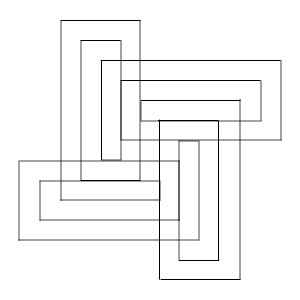
Sequence 7 (7, 5, 3, 1, 8, 6, 4, 2, 9):
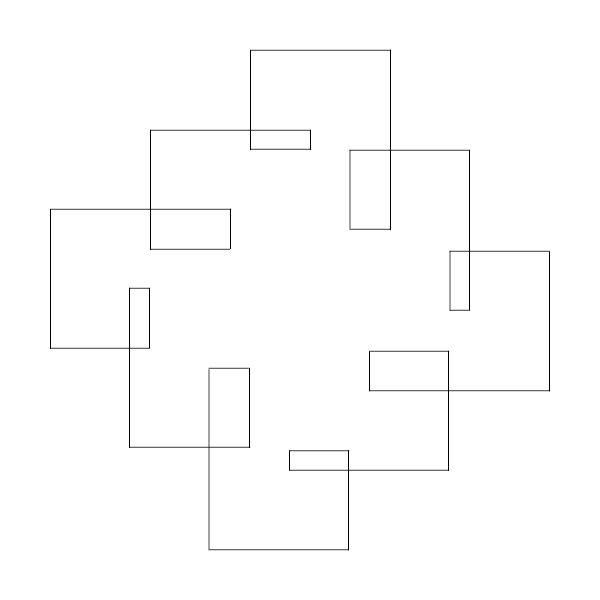
Sequences 2, 4, and 8 produced the same patterns, but in the reverse direction. Sequences 3 and 6, I felt, were too simple — four connected or overlapping rectangles in the same turning shape. The one row that didn't produce such a shape was row 9, which gave only a square.
At this point, I could appreciate for myself how the numbers of the Vedic square could be kind of cosmic, or why people might see them as holy, magical, or divine. The sequences are so simple, but if you follow them with one unbroken line, you create a shape that turns forever, and you always end up back where you began.
If you think this says something about the nature of life and the universe, then you'll probably find this either depressing or comforting.
I did two more designs by turning at a 45-degree angle. Here's sequence 2:
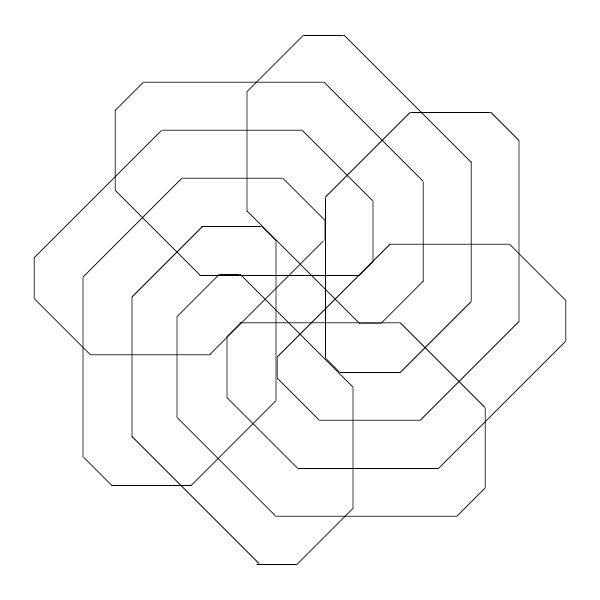
and sequence 5:

Of course, these things just beg to be colored, so I also printed out this last one and used it as a template for this:
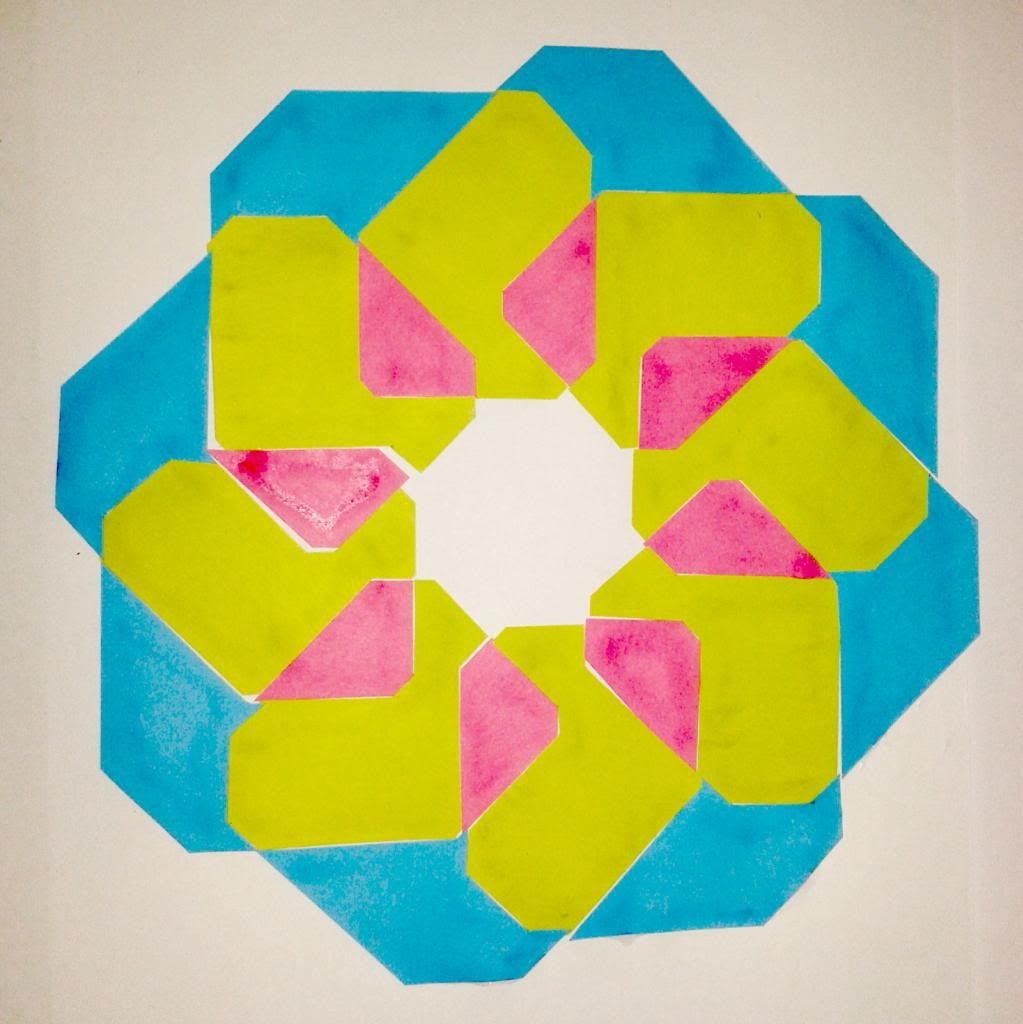
To my frustration, of course, doing this with paper wasn't as neat as it was on the computer. But, I like it enough to want to make more. And I still have other angles to try.
I've always admired the geometric designs in Islamic art and architecture but figured that the math involved would be too complicated to learn. But, another recent Good Job Brain episode unlocked at least one secret for me by telling me about the Vedic square.
You can go ahead and read the brief Wikipedia article article about it, but the Vedic square is a 9x9 table that shows digital roots — the remainder of ((x * y) / 9) — instead of multiplication products:

Thanks, Wikipedia.
If you draw lines connecting all the same digital roots in the square, you can already make some pretty neat shapes.
But you can also make simple, elegant designs if you take a whole row from the square, use the numbers in that row as measurements, and keep turning your paper at a certain angle until you get back to where you started.
Of course, those instructions might be difficult to understand without an example, but I'll get to those in a bit; please bear with my nerding out a little longer.
I tried to go all pen-and-paper for this, but it turns out that my protractor is inexact, so I put these black-and-white drawings together on a computer. Even then, I had trouble getting everything to line up just right, so I really have to hand it to the first artists who worked with these measurements by hand.
Whatever angle you choose, it looks like you'll get yourself nine possible shapes. I first went with all 90-degree angles, and all but one row led me to produce these swastika-like shapes. This is the one with sequence 1 (1, 2, 3, … , 9):

Sequence 5 (5, 1, 6, 2, 7, 3, 8, 4, 9):

Sequence 7 (7, 5, 3, 1, 8, 6, 4, 2, 9):

Sequences 2, 4, and 8 produced the same patterns, but in the reverse direction. Sequences 3 and 6, I felt, were too simple — four connected or overlapping rectangles in the same turning shape. The one row that didn't produce such a shape was row 9, which gave only a square.
At this point, I could appreciate for myself how the numbers of the Vedic square could be kind of cosmic, or why people might see them as holy, magical, or divine. The sequences are so simple, but if you follow them with one unbroken line, you create a shape that turns forever, and you always end up back where you began.
If you think this says something about the nature of life and the universe, then you'll probably find this either depressing or comforting.
I did two more designs by turning at a 45-degree angle. Here's sequence 2:

and sequence 5:

Of course, these things just beg to be colored, so I also printed out this last one and used it as a template for this:

To my frustration, of course, doing this with paper wasn't as neat as it was on the computer. But, I like it enough to want to make more. And I still have other angles to try.
18 September 2013
Letter No. 26
I’ve been thinking a lot about how alone we all really are. It’s something I’ve believed for a long while, but the feeling of loneliness that usually comes with thoughts like, We really are alone, has been heightened in the past month or so.
My brother Mikko is now in Spain to study, and that makes me, once again, the only member of my immediate family living in Manila. Even though we went to the same college and lived in adjacent dorms for a year, I never really made an effort to see or talk to him. Today, I wish I had, but I guess I was too consumed with senior year, then the struggle of figuring myself out and the challenge of the first attempt at a grown-up relationship.
When I think back now to those years of tears, I wonder, Why didn’t I just head north then to see Mikko? If I missed my family so much, why didn’t I seek him, my own brother, out?
I guess I thought he wouldn’t understand. I was the older sibling; I was supposed to know what I was doing. So I was surprised to find, after he moved to Makati and we started meeting for church every Sunday, that he could actually be a good influence on me.
I put something like this in the letter I gave him shortly before he left: Being around him helped to ground me. I'd spent the past couple of years alone, making decisions about the kind of person I wanted to be. Mikko's presence allowed me to check those decisions and that person against my family's attitudes and expectations. He didn't ask me these questions; just hanging out with him, walking around, and chatting about his own post-college adventures led me to ask myself: Am I really okay with how different I'm becoming? Am I being good; am I a good person?
I only saw Mikko once a week, but the clarity I got from those Sundays was such a great addition to my life. I decided that I wanted to elicit with my life the kind of pride that I already felt for my younger brother.
(And when it comes down to it, having family around helped me deal with how I felt after that first grown-up attempt at a relationship crumbled like a soggy cookie.)
Now, I'm on my own again.
The thing now is, for all I've learned about my brother, and for all the time I've spent with Cris, I can't help thinking that you can't really know somebody 100%. There's always something about yourself that feels like something known by you and you alone — you are alone in your knowledge.
For all I know about his dreams and his quirks, I know that there's still stuff going on in Mikko's head that I will probably never see, just like there's stuff going on in my head that I wonder if anybody else can see. When I'm in the car with Cris and we are quiet, or when he's watching TV while I'm playing a computer game, I feel as though the hands of my brain are trying to reach into his skull and his chest to try and get a hold on some of the mysteries waiting in there.
When I peel away layers and layers of my own identity — childhood memories, sense of humor, favorite colors, love of pizza and sashimi, family ties, anxiety upon anxiety tied with a bow of anxiety, scars self-inflicted and not, my oldest friends, grammar, languages, left-handedness — and see what's left there, staring back at me, I wonder if anyone else can see that, especially if I can't describe it to them anymore. So it makes me wonder if I see other people the way they'd like to be seen — if I ever can or will.
And even if I must accept that I'll never see another person 100%, is there a certain percentage of them I should be able to see, to be able to say that I know them? Why is it that, for all the lunches, blankets, hopes, and fears I've shared, I still feel like I can't be seen 100%?
Or should it be enough that, despite how little or much they do see, the people I love make me feel that it's okay to be 100% myself? Is it better to be content to give and receive that kind of compassion than to keep picking at all the layers in the hopes of finding whatever's really underneath?
As an early birthday present to myself, I bought a copy of The Sims 3. I know the game came out years ago, but I haven't had the right computer for it until now — and it's not even my computer; Cris just lets me use his every now and then.
I find the game eerily realistic in that the Sims claim to have good relationships with one another yet spend nearly all their time on their own pursuits. The family founders had a whirlwind romance and then barely saw each other after they got married and had kids, yet whenever one entered the room, the other's mood would rise. The eldest child is grumpy, neurotic, dislikes children, and spends most of her time writing or jogging, but she seems to enjoy family dinners and isn't above changing a niece or nephew's diaper if necessary. The son-in-law knew his mother-in-law for only a Sim week or so, but he bawled like the rest of them when she passed away. Should I aspire to be more like the people I've made, happy to simply be with each other, even if they don't seem to actually know each other?
My brother Mikko is now in Spain to study, and that makes me, once again, the only member of my immediate family living in Manila. Even though we went to the same college and lived in adjacent dorms for a year, I never really made an effort to see or talk to him. Today, I wish I had, but I guess I was too consumed with senior year, then the struggle of figuring myself out and the challenge of the first attempt at a grown-up relationship.
When I think back now to those years of tears, I wonder, Why didn’t I just head north then to see Mikko? If I missed my family so much, why didn’t I seek him, my own brother, out?
I guess I thought he wouldn’t understand. I was the older sibling; I was supposed to know what I was doing. So I was surprised to find, after he moved to Makati and we started meeting for church every Sunday, that he could actually be a good influence on me.
I put something like this in the letter I gave him shortly before he left: Being around him helped to ground me. I'd spent the past couple of years alone, making decisions about the kind of person I wanted to be. Mikko's presence allowed me to check those decisions and that person against my family's attitudes and expectations. He didn't ask me these questions; just hanging out with him, walking around, and chatting about his own post-college adventures led me to ask myself: Am I really okay with how different I'm becoming? Am I being good; am I a good person?
I only saw Mikko once a week, but the clarity I got from those Sundays was such a great addition to my life. I decided that I wanted to elicit with my life the kind of pride that I already felt for my younger brother.
(And when it comes down to it, having family around helped me deal with how I felt after that first grown-up attempt at a relationship crumbled like a soggy cookie.)
Now, I'm on my own again.
The thing now is, for all I've learned about my brother, and for all the time I've spent with Cris, I can't help thinking that you can't really know somebody 100%. There's always something about yourself that feels like something known by you and you alone — you are alone in your knowledge.
For all I know about his dreams and his quirks, I know that there's still stuff going on in Mikko's head that I will probably never see, just like there's stuff going on in my head that I wonder if anybody else can see. When I'm in the car with Cris and we are quiet, or when he's watching TV while I'm playing a computer game, I feel as though the hands of my brain are trying to reach into his skull and his chest to try and get a hold on some of the mysteries waiting in there.
When I peel away layers and layers of my own identity — childhood memories, sense of humor, favorite colors, love of pizza and sashimi, family ties, anxiety upon anxiety tied with a bow of anxiety, scars self-inflicted and not, my oldest friends, grammar, languages, left-handedness — and see what's left there, staring back at me, I wonder if anyone else can see that, especially if I can't describe it to them anymore. So it makes me wonder if I see other people the way they'd like to be seen — if I ever can or will.
And even if I must accept that I'll never see another person 100%, is there a certain percentage of them I should be able to see, to be able to say that I know them? Why is it that, for all the lunches, blankets, hopes, and fears I've shared, I still feel like I can't be seen 100%?
Or should it be enough that, despite how little or much they do see, the people I love make me feel that it's okay to be 100% myself? Is it better to be content to give and receive that kind of compassion than to keep picking at all the layers in the hopes of finding whatever's really underneath?
As an early birthday present to myself, I bought a copy of The Sims 3. I know the game came out years ago, but I haven't had the right computer for it until now — and it's not even my computer; Cris just lets me use his every now and then.
I find the game eerily realistic in that the Sims claim to have good relationships with one another yet spend nearly all their time on their own pursuits. The family founders had a whirlwind romance and then barely saw each other after they got married and had kids, yet whenever one entered the room, the other's mood would rise. The eldest child is grumpy, neurotic, dislikes children, and spends most of her time writing or jogging, but she seems to enjoy family dinners and isn't above changing a niece or nephew's diaper if necessary. The son-in-law knew his mother-in-law for only a Sim week or so, but he bawled like the rest of them when she passed away. Should I aspire to be more like the people I've made, happy to simply be with each other, even if they don't seem to actually know each other?
06 September 2013
thing-a-week 33-36: a month of kirigami drills
I've been itching to make more kirigami models but haven't had any good ideas lately, so I decided to do some exercises with stairs. I still haven't come up with any new ideas for models after this, but I can say I've gotten faster at drafting models to cut. The exercises have also helped me see potential technical missteps I might make if and when I do have something new to work on.
And, of course, kirigami is always therapeutic.
33: I came up with this after staring at some Masahiro Chatani models on the Internet. It was supposed to be more complex, but I was off at the start by a few centimeters, and that affected how much room I had for more layers.
In general, I work in centimeters and half-centimeters; any smaller can get hard to fold.
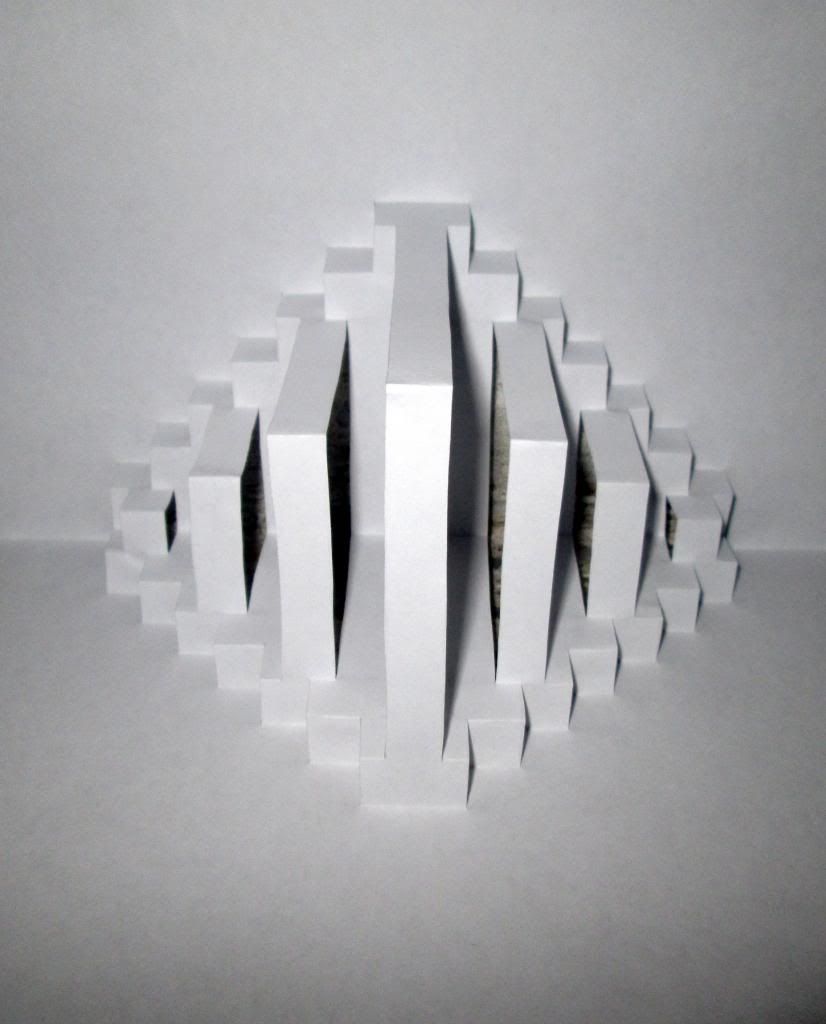
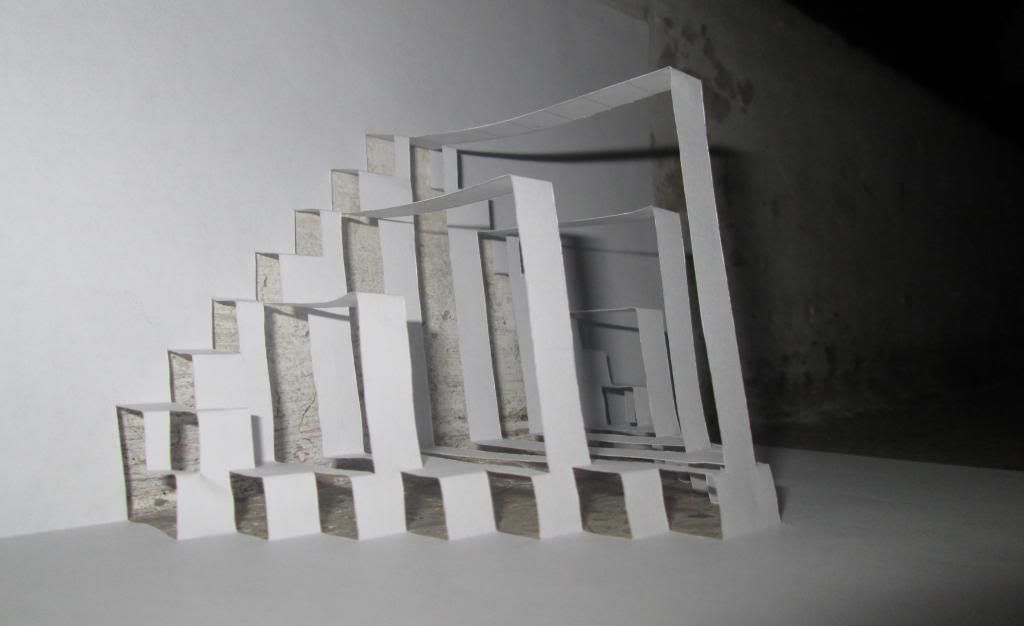
34: This one was more messing around than an exercise, but the nesting arch trick here helped me figure something out for a card/letter I made for my brother later that week. (I guess I did have a new idea. But since it's personal, I'm not going to post photos of it here.)
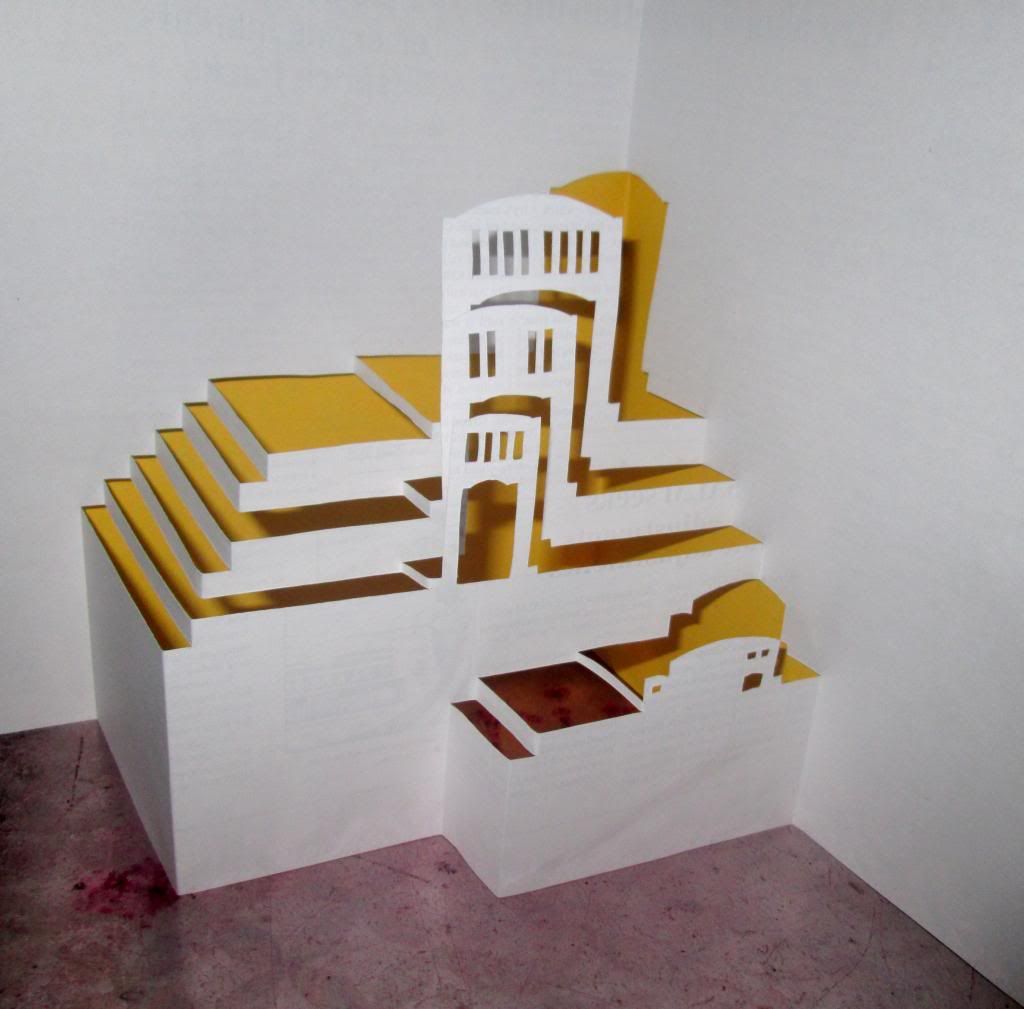
35: This was another exercise I set for myself after looking at Masahiro Chatani models.
Folding adjacent stairs like these needs some care; you can see diagonal bumps where the staircase in front pulled on the one in the back.
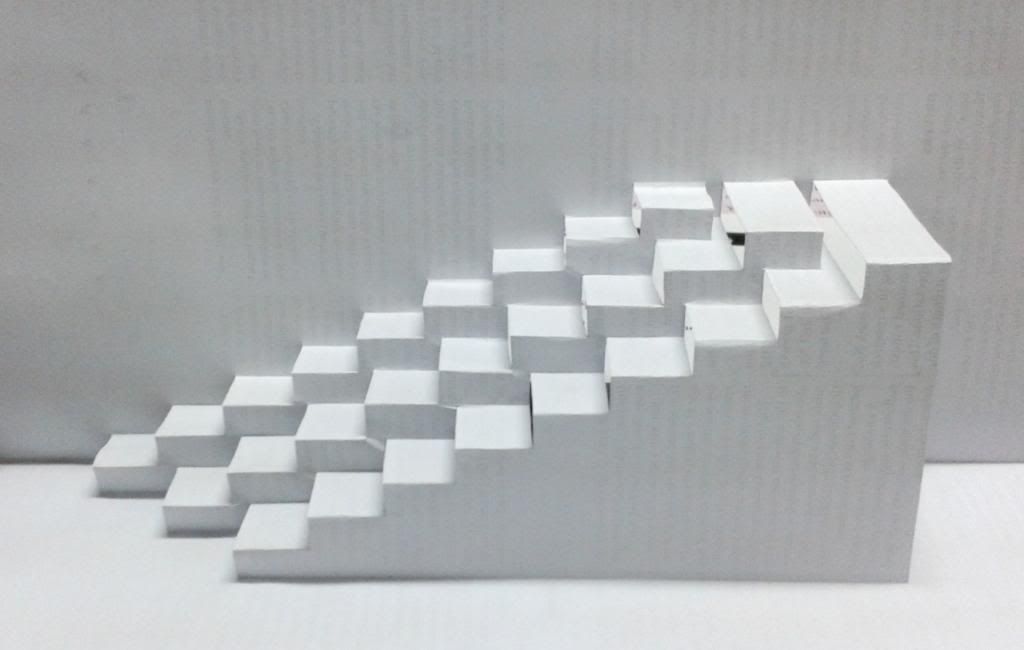
36: I saw some photos of Chand Baori, which appeared in that really gorgeous Tarsem Singh movie, The Fall, as well as in The Dark Knight Rises. Yes, yes, more stairs.
The difficulty I had with this model was measuring the base. I wanted stairs all the way to the base, but again, I had some measurement problems. You can also see some wrong creases at the base due to those problems.
While it looks nice, I'm not fond of horizontal models that go so far out from the spine; if the paper is soft or becomes soft (e.g. from moisture or from someone sitting on it by accident), it starts to collapse in on itself.

And, of course, kirigami is always therapeutic.
33: I came up with this after staring at some Masahiro Chatani models on the Internet. It was supposed to be more complex, but I was off at the start by a few centimeters, and that affected how much room I had for more layers.
In general, I work in centimeters and half-centimeters; any smaller can get hard to fold.


34: This one was more messing around than an exercise, but the nesting arch trick here helped me figure something out for a card/letter I made for my brother later that week. (I guess I did have a new idea. But since it's personal, I'm not going to post photos of it here.)

35: This was another exercise I set for myself after looking at Masahiro Chatani models.
Folding adjacent stairs like these needs some care; you can see diagonal bumps where the staircase in front pulled on the one in the back.

36: I saw some photos of Chand Baori, which appeared in that really gorgeous Tarsem Singh movie, The Fall, as well as in The Dark Knight Rises. Yes, yes, more stairs.
The difficulty I had with this model was measuring the base. I wanted stairs all the way to the base, but again, I had some measurement problems. You can also see some wrong creases at the base due to those problems.
While it looks nice, I'm not fond of horizontal models that go so far out from the spine; if the paper is soft or becomes soft (e.g. from moisture or from someone sitting on it by accident), it starts to collapse in on itself.

12 August 2013
thing-a-week 28, 29, 30, 31, 32: Excuses and My Lumpy Heart
I'm truly sorry that I haven't been able to keep up this series in the past month or so.
I could blame this on several things. It took me a couple of weeks, for instance, to find and then move my things into a new apartment. That was last month, though, and my things still aren't unpacked. I'm not actually living in the place yet because the bolts that hold my bed together got lost in the last move, so I'm still going through hardware stores and looking for right-sized replacements. And in the meantime, I'm still lodging with friends, making a longer commute, and being tired.
I wrote in June that I liked the extra time that my new work hours gave me, but these days, I spend more of that extra time just spacing out, emptying my head from the night before and recovering just enough for the one ahead.
And while I tell myself that I should be glad for the rest, I also know that making things helps me to rest, and I just haven't made enough time to make things.
For week 28, I made two flexagons with abstract designs. I actually worked on them at the office while waiting for each day's editorial meeting, cutting and folding and drawing a little each day.
Unfortunately, they just disappeared from my desk one morning or evening. Either I actually slipped them into a book or notebook to work on elsewhere and then simply lost them, or someone found them interesting and took them, like they took two of my modular hassocks.
As for week 29, sorry to subject you to more of my abysmal drawing skills, but all I have to show for that week is this drawing of a land hermit crab.
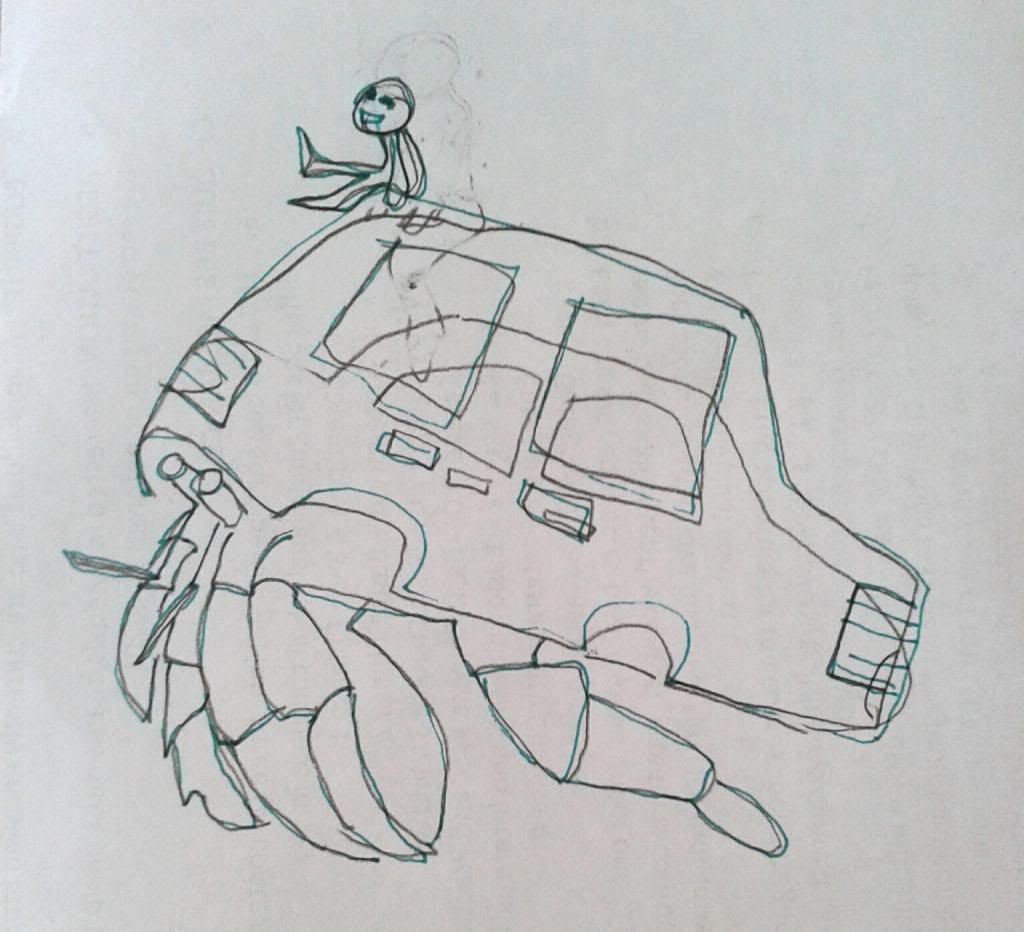
Sometimes, Cris and I listen to trivia podcast Good Job Brain in the car together, and one episode explained how land hermit crabs swap shells. We happened to be surrounded by SUVs then, so I started to imagine a not-so-distant future where land hermit crabs are hulking monsters. They use hollowed out cars as shells and trade up as they grow, from VW beetles to hummers and even buses and container vans. For entertainment, people go to arenas to watch the crabs fight for bigger shells.
For this drawing, I used a photo of a crab as a reference but was too lazy to put more work into the SUV. Perhaps once I have a story fleshed out, I can ask a more talented friend to illustrate.
Week 30 was the worst. I was supposed to complete my Processing project that week but ended up resigning the whole course. While I liked my project idea, the course itself no longer held my interest; its objectives were more and more clearly different from my own. So, I decided to just remember the sunk cost fallacy, quit the course, recover from my burnout, and save my project for another day.
All I have to offer for week 30, then, is a screenshot of some of the code I worked on while I was still working on it.

I don't know if you'd count the code, so I don't know if you'd count what I made in week 31, either.
I recently joined a Facebook group of fellow former Glitch players. I thought my stay wouldn't be long, but it turns out that there are many other people who also still feel sad that Glitch is gone, however silly it might seem to have so much feeling for a closed computer game. There's just nothing like it out there.
One day, a game developer invited the group to test a new game, Manyland. While the game wasn't going to be anything like Glitch, the developers had heard about the culture of Glitch players and were hoping we could bring some of that to the game.
So, week 31 saw me testing Manyland when I could. I can best describe it as a two-dimensional LEGO, though Minecraft players say it's like Minecraft. It is lots of fun but kind of lonely; perhaps due to lack of other players and a map, it gets existential fast — where am I? Why am I here? Where does this world end? If I build a platform far enough, will I go all the way around to where I began?
One of the first things I built was this simple brick box house with an underground swimming cavern and tiny wine cellar:
You can actually change the color of the sky, and the colors blend as you move across the screen, but when you take screenshots, you get just the color of the sky (and any translucent things, like water) based on your current position. The little gnome-like person in this assembled screenshots is actually me.
If you prefer something more traditional than code or digital building, then week 31 was also when I started work on the craft for week 32:

Week 32 was a nice return to paper. One of the secretaries at work used to spend her free time on complex, three-dimensional paper models of video game and cartoon characters. I wanted to try one of those but didn't want just any model. When I saw the Paper Torso by Horst Kiechle, it felt best for me.
I printed out the template of a human heart; the pieces took up about eight-and-a-half sheets of letter-size paper, and I did the cutting and folding in my spare time. I then glued all the pieces together in about three hours yesterday.
Photos of the resulting heart are below. It is pretty lumpy for several reasons: I cut next to some of the lines and not on them, and not all of my cuts were straight, so some of the triangles did not fit each other the way they were supposed to. I also used regular bond paper, which absorbed moisture from all the rain we've had lately and thus made the whole thing softer and easier to dent. While assembling the valves, I found I'd inverted a section and so had to push and pull it without tearing the whole thing apart.
But, it's mine, and I am happy to have made it, lumps and all.
Please excuse the awkward hand poses. I needed to keep a hold on the heart, but not too tightly, or I would have crushed it.

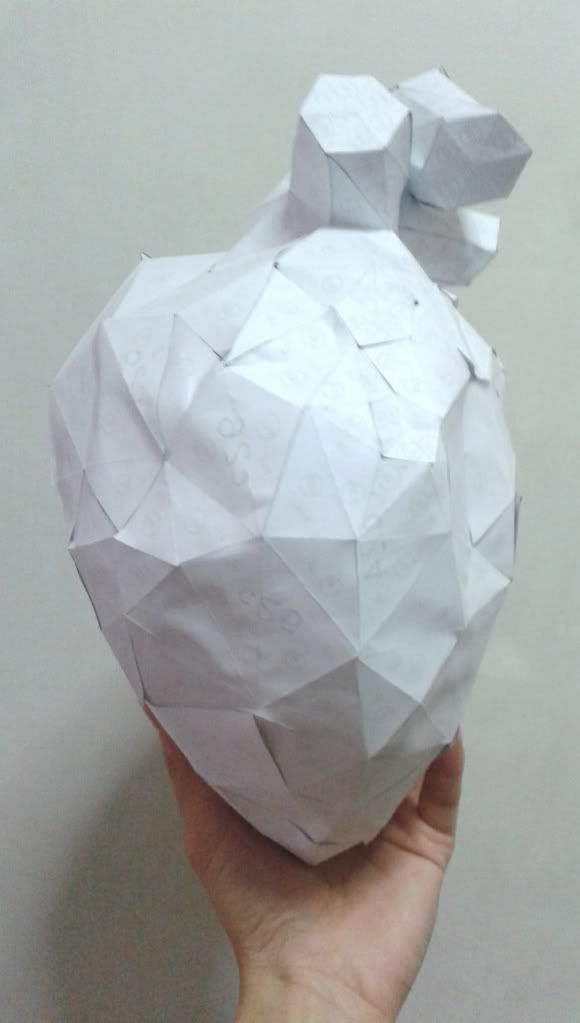

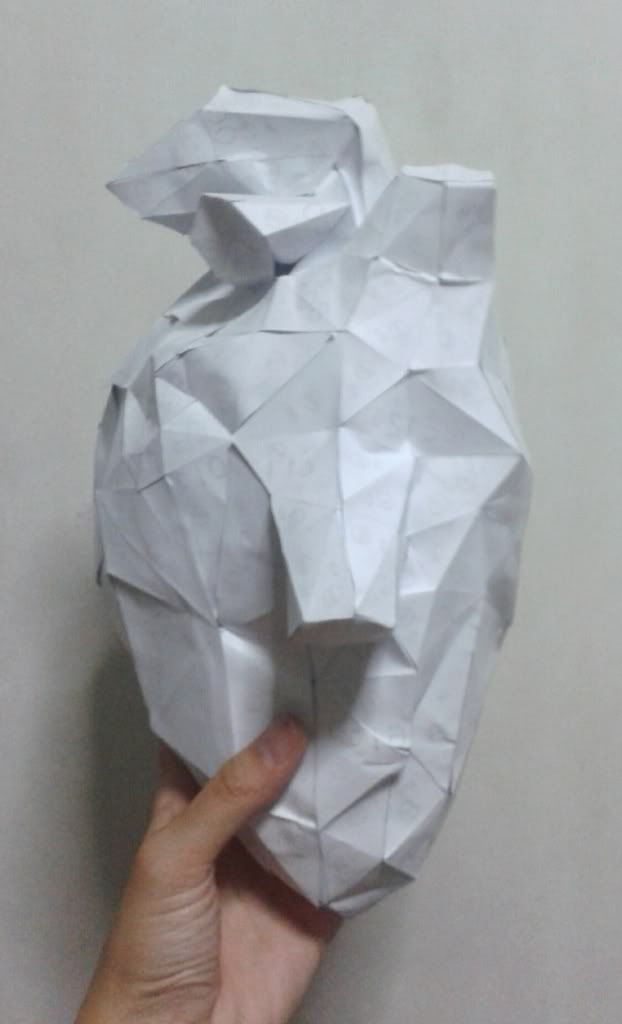
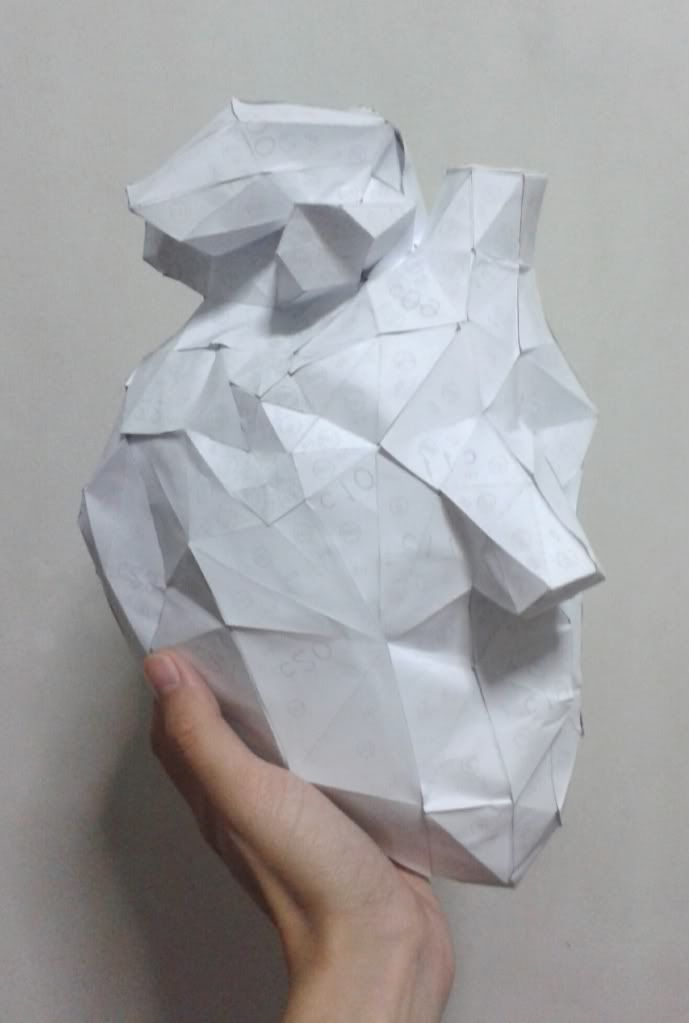
This project was lots of fun but also kind of weird. I knew what it was supposed to look like, and I knew that it was taking shape, but only when I had the whole thing in my hands did I think, This is a heart. I stood with it in front of a mirror just to see how big it was, and I somehow felt very small, cradling a white paper heart in my palms against my pink shirt.
I am thinking of doing lungs next, even if I don't even know what to do with the heart now.
The heart template is just one in a set of templates to build a neutered human torso. There are more templates on Mr. Kiechle's Paper Torso website; feel free to share with students, crafty doctors, and anybody else who might like the idea of making human organs out of paper.
Other stuff I feel like sharing: this waterfall cabin I built in Manyland, accessible only by falling into the water and swimming down (water is weird in Manyland) and exit-able only by magic wind. Unless you cheat and build ladders or platforms, any other way brings death.
I also built this temple, but in hindsight, the color of the bricks I used makes the whole thing look like something else; something less, uh, temple-y.
The magic wind from the cabin will actually bring you here; you pop out of the gap on the right, next to the cacti.
I don't actually get to play Manyland that often; I only play it at home, and it depends on how I'm feeling. But it is lots of fun, and as the game is still in its early stages, the developers are quite reachable for help, feedback, and bug reports. If any of you get to play, my username is kalsangikid.
I could blame this on several things. It took me a couple of weeks, for instance, to find and then move my things into a new apartment. That was last month, though, and my things still aren't unpacked. I'm not actually living in the place yet because the bolts that hold my bed together got lost in the last move, so I'm still going through hardware stores and looking for right-sized replacements. And in the meantime, I'm still lodging with friends, making a longer commute, and being tired.
I wrote in June that I liked the extra time that my new work hours gave me, but these days, I spend more of that extra time just spacing out, emptying my head from the night before and recovering just enough for the one ahead.
And while I tell myself that I should be glad for the rest, I also know that making things helps me to rest, and I just haven't made enough time to make things.
For week 28, I made two flexagons with abstract designs. I actually worked on them at the office while waiting for each day's editorial meeting, cutting and folding and drawing a little each day.
Unfortunately, they just disappeared from my desk one morning or evening. Either I actually slipped them into a book or notebook to work on elsewhere and then simply lost them, or someone found them interesting and took them, like they took two of my modular hassocks.
As for week 29, sorry to subject you to more of my abysmal drawing skills, but all I have to show for that week is this drawing of a land hermit crab.

Sometimes, Cris and I listen to trivia podcast Good Job Brain in the car together, and one episode explained how land hermit crabs swap shells. We happened to be surrounded by SUVs then, so I started to imagine a not-so-distant future where land hermit crabs are hulking monsters. They use hollowed out cars as shells and trade up as they grow, from VW beetles to hummers and even buses and container vans. For entertainment, people go to arenas to watch the crabs fight for bigger shells.
For this drawing, I used a photo of a crab as a reference but was too lazy to put more work into the SUV. Perhaps once I have a story fleshed out, I can ask a more talented friend to illustrate.
Week 30 was the worst. I was supposed to complete my Processing project that week but ended up resigning the whole course. While I liked my project idea, the course itself no longer held my interest; its objectives were more and more clearly different from my own. So, I decided to just remember the sunk cost fallacy, quit the course, recover from my burnout, and save my project for another day.
All I have to offer for week 30, then, is a screenshot of some of the code I worked on while I was still working on it.

I don't know if you'd count the code, so I don't know if you'd count what I made in week 31, either.
I recently joined a Facebook group of fellow former Glitch players. I thought my stay wouldn't be long, but it turns out that there are many other people who also still feel sad that Glitch is gone, however silly it might seem to have so much feeling for a closed computer game. There's just nothing like it out there.
One day, a game developer invited the group to test a new game, Manyland. While the game wasn't going to be anything like Glitch, the developers had heard about the culture of Glitch players and were hoping we could bring some of that to the game.
So, week 31 saw me testing Manyland when I could. I can best describe it as a two-dimensional LEGO, though Minecraft players say it's like Minecraft. It is lots of fun but kind of lonely; perhaps due to lack of other players and a map, it gets existential fast — where am I? Why am I here? Where does this world end? If I build a platform far enough, will I go all the way around to where I began?
One of the first things I built was this simple brick box house with an underground swimming cavern and tiny wine cellar:
Click to enlarge. Photobucket messes with image URLs as links, so you might have to click on a couple of magnifying glasses to see this at actual size.
You can actually change the color of the sky, and the colors blend as you move across the screen, but when you take screenshots, you get just the color of the sky (and any translucent things, like water) based on your current position. The little gnome-like person in this assembled screenshots is actually me.
If you prefer something more traditional than code or digital building, then week 31 was also when I started work on the craft for week 32:

Week 32 was a nice return to paper. One of the secretaries at work used to spend her free time on complex, three-dimensional paper models of video game and cartoon characters. I wanted to try one of those but didn't want just any model. When I saw the Paper Torso by Horst Kiechle, it felt best for me.
I printed out the template of a human heart; the pieces took up about eight-and-a-half sheets of letter-size paper, and I did the cutting and folding in my spare time. I then glued all the pieces together in about three hours yesterday.
Photos of the resulting heart are below. It is pretty lumpy for several reasons: I cut next to some of the lines and not on them, and not all of my cuts were straight, so some of the triangles did not fit each other the way they were supposed to. I also used regular bond paper, which absorbed moisture from all the rain we've had lately and thus made the whole thing softer and easier to dent. While assembling the valves, I found I'd inverted a section and so had to push and pull it without tearing the whole thing apart.
But, it's mine, and I am happy to have made it, lumps and all.
Please excuse the awkward hand poses. I needed to keep a hold on the heart, but not too tightly, or I would have crushed it.





This project was lots of fun but also kind of weird. I knew what it was supposed to look like, and I knew that it was taking shape, but only when I had the whole thing in my hands did I think, This is a heart. I stood with it in front of a mirror just to see how big it was, and I somehow felt very small, cradling a white paper heart in my palms against my pink shirt.
I am thinking of doing lungs next, even if I don't even know what to do with the heart now.
The heart template is just one in a set of templates to build a neutered human torso. There are more templates on Mr. Kiechle's Paper Torso website; feel free to share with students, crafty doctors, and anybody else who might like the idea of making human organs out of paper.
Other stuff I feel like sharing: this waterfall cabin I built in Manyland, accessible only by falling into the water and swimming down (water is weird in Manyland) and exit-able only by magic wind. Unless you cheat and build ladders or platforms, any other way brings death.
I also built this temple, but in hindsight, the color of the bricks I used makes the whole thing look like something else; something less, uh, temple-y.
The magic wind from the cabin will actually bring you here; you pop out of the gap on the right, next to the cacti.
I don't actually get to play Manyland that often; I only play it at home, and it depends on how I'm feeling. But it is lots of fun, and as the game is still in its early stages, the developers are quite reachable for help, feedback, and bug reports. If any of you get to play, my username is kalsangikid.
20 July 2013
11 July 2013
Letter No. 24
When I was about 10 or 12, I passed a lot of time one summer by watching forensics shows on the Discovery Channel. This was before the local cable company carried any channels that showed CSI or similar.
The fact that the police could solve crimes using the imprint of a doodle on a (falsified) note or based on whether a victim's hash browns had onions the morning he died just blew me away. I was so fascinated by these shows that I even wanted to become a forensic scientist when I grew up, but I think an adult told me that forensics in the Philippines was nowhere near as advanced as the stuff I saw on TV, so that ambition got stabbed in the neck, stowed in a trunk, and pushed off the end of the farthest dock at the port. Perhaps, if someone had encouraged me to try and be a pioneer in the field, I would be in a lab right now, matching an insect found in somebody's ear, but life turned out different.
Anyway, one sunny day, I saw something on one of those shows that has stayed with me to this day. It wasn't a bloody crime scene photo, a picture of a murder weapon, or a still-innocent victim's face. It was a comparison of the corners of a criminal's lips. There was a portrait photo of the guy — white American male; clean-looking, mid-20th-century type with a sort of crew cut and thick-rimmed glasses — taken at around the time he'd committed the crime, and there was another portrait of him 10 or 20 years later, after he'd moved, married, and had a family, and before the law finally caught up with him.
In both portraits, the man hadn't smiled; he'd simply looked right at the camera. The scientist or the host explained that, genetics aside, the way the corners of the man's mouth turned up while he was young meant that he'd been quite happy with his life and confident. Then, when he was older, the way the corners sloped all the way down meant that he hadn't taken life well and didn't have much to be happy about.
I don't even remember why they were discussing the shape of this guy's mouth, but the conclusions struck me. Until then, I'd thought it was impossible for someone to commit a crime and then go on to lead an average life. But I was even more amazed that, though the guy professed no guilt, his face showed that all he'd gained after his crime seemed to have done little for his ultimate happiness.
I didn't actually think anyone would analyze my portraits over the years, but I resolved that day to never let the corners of my mouth go down. Maybe that was the day I learned that life could take a toll on you, and you wouldn't even notice until you were old. Defeat would be there on your face, every time you looked in a mirror, and there might even be nothing you could do — I don't think I'd known about plastic surgery yet — to change it.
I remember checking my mouth in the mirror and being dissatisfied with its shape, a curve that just fell away from the center. But — ! The curve still turned up at the ends, where it mattered. There was hope for me yet. I could still do all I could to be happy, and when I got old, the proof of my good life would be there on my face.
It feels silly to write that, knowing that I now check my happiness level by looking inside myself and not in a mirror — and knowing that scientists today might already have dismissed mouth corner analysis as hooey. But still, if the corners of my mouth catch my eye in a reflection, the vague memory of that guy's two portraits comes floating up, and I check how my own curve is doing. Still upward? Good, then.
I let my facial muscles yank at both ends of my mouth to relax it, and then I briefly twitch the corners up into a smile. Sometimes, I do this even when I'm not looking in a mirror — when, for whatever reason, I suddenly become conscious of the way my face is set. It's a quick and quiet way to tell myself, Remember to be happy.
This is probably the best thing I've learned from a forensics show.
The fact that the police could solve crimes using the imprint of a doodle on a (falsified) note or based on whether a victim's hash browns had onions the morning he died just blew me away. I was so fascinated by these shows that I even wanted to become a forensic scientist when I grew up, but I think an adult told me that forensics in the Philippines was nowhere near as advanced as the stuff I saw on TV, so that ambition got stabbed in the neck, stowed in a trunk, and pushed off the end of the farthest dock at the port. Perhaps, if someone had encouraged me to try and be a pioneer in the field, I would be in a lab right now, matching an insect found in somebody's ear, but life turned out different.
Anyway, one sunny day, I saw something on one of those shows that has stayed with me to this day. It wasn't a bloody crime scene photo, a picture of a murder weapon, or a still-innocent victim's face. It was a comparison of the corners of a criminal's lips. There was a portrait photo of the guy — white American male; clean-looking, mid-20th-century type with a sort of crew cut and thick-rimmed glasses — taken at around the time he'd committed the crime, and there was another portrait of him 10 or 20 years later, after he'd moved, married, and had a family, and before the law finally caught up with him.
In both portraits, the man hadn't smiled; he'd simply looked right at the camera. The scientist or the host explained that, genetics aside, the way the corners of the man's mouth turned up while he was young meant that he'd been quite happy with his life and confident. Then, when he was older, the way the corners sloped all the way down meant that he hadn't taken life well and didn't have much to be happy about.
I don't even remember why they were discussing the shape of this guy's mouth, but the conclusions struck me. Until then, I'd thought it was impossible for someone to commit a crime and then go on to lead an average life. But I was even more amazed that, though the guy professed no guilt, his face showed that all he'd gained after his crime seemed to have done little for his ultimate happiness.
I didn't actually think anyone would analyze my portraits over the years, but I resolved that day to never let the corners of my mouth go down. Maybe that was the day I learned that life could take a toll on you, and you wouldn't even notice until you were old. Defeat would be there on your face, every time you looked in a mirror, and there might even be nothing you could do — I don't think I'd known about plastic surgery yet — to change it.
I remember checking my mouth in the mirror and being dissatisfied with its shape, a curve that just fell away from the center. But — ! The curve still turned up at the ends, where it mattered. There was hope for me yet. I could still do all I could to be happy, and when I got old, the proof of my good life would be there on my face.
It feels silly to write that, knowing that I now check my happiness level by looking inside myself and not in a mirror — and knowing that scientists today might already have dismissed mouth corner analysis as hooey. But still, if the corners of my mouth catch my eye in a reflection, the vague memory of that guy's two portraits comes floating up, and I check how my own curve is doing. Still upward? Good, then.
I let my facial muscles yank at both ends of my mouth to relax it, and then I briefly twitch the corners up into a smile. Sometimes, I do this even when I'm not looking in a mirror — when, for whatever reason, I suddenly become conscious of the way my face is set. It's a quick and quiet way to tell myself, Remember to be happy.
This is probably the best thing I've learned from a forensics show.
02 July 2013
thing-a-week 26, 27: "A Bat Above" (Phase 1)
I was able to fish out my scanner, so for Week 26, you get a scan of a new drawing I made for my Processing project.
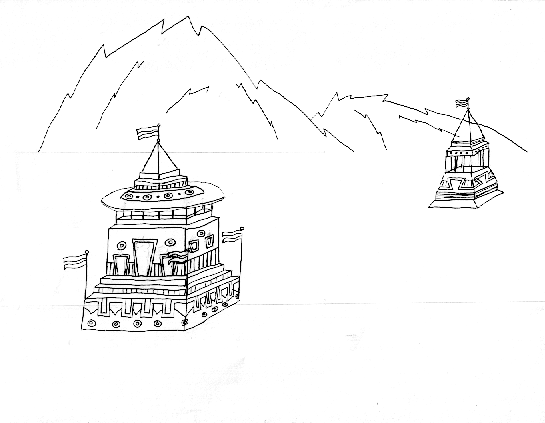
I actually like the first drawing a lot more, but I didn't want the drawing I used to be too much like the reference photograph. I might still make another.
For the first time in this series, I'm presenting a digital work. Week 27's craft is the first phase of my Processing project, as submitted. Here also is the project information, just for reference.
The class requires us to either submit two different projects or submit two phases of one project.
DESCRIPTION
This is only the first stage of the project; my final submission will be a simple coin-collecting game.
"A Bat Above" is inspired by Glitch (www.glitch.com), an MMO game that closed late last year. My project imagines what it might be like for the cave-dwelling batterfly, an in-game animal, to emerge from the caves after the game's closing and roam an empty landscape while wondering where all the players have gone.
I want my project to be enjoyed by everyone, though — not just former Glitch players.
At this point, the game doesn't have the coin-collecting mechanics yet. I focused on the design and music — the general look and feel. It's not much, but it's what I've managed to put together so far.
I drew the background by hand, and the background music is a mix I made using sounds from freesound.org. The bat is moved by the mouse pointer.
SCREENCAST
BACKGROUND MUSIC
(The screencast did not capture the music during the demo, so I uploaded the music to SoundCloud.)
REFERENCES
The sound of birds chirping is by hanstimm, who released it on freesound.org under a Creative Commons Attribution-Noncommercial license.
The piano loop is by Erokia, who released it on freesound.org under a Creative Commons Attribution license.
The batterfly sprite is by Tiny Speck, who released it on glitch.com under a Creative Commons Attribution-Noncommercial-ShareAlike license.
The music is played using the Maxim Java API provided by the course instructors.
I referred heavily to the processing.org examples on sprite animation and object-oriented programming.
Last but not least, Will Gallia in the forums helped me figure out how to get the background to scroll.
--
It looks like I forgot to cite Cory Richards, the guy who took the Tsarang temples photo I used as inspiration. I'll have to remember him at the next submission.
The background music and the screencast were firsts for me. Obviously, my sound mixing is kindergarten-level; I just threw hanstimm and Erokia's sounds together in Audacity. The credit really belongs to them.
I hope that by next deadline, I'll have figured out how to capture the in-game sound with the screencast, or how to export the whole thing as a web app, so people actually get to try it.
(I wish I could share some of the projects I made for Python class, but doing so would be considered leakage and might lead future students to violate the honor code.)

I actually like the first drawing a lot more, but I didn't want the drawing I used to be too much like the reference photograph. I might still make another.
For the first time in this series, I'm presenting a digital work. Week 27's craft is the first phase of my Processing project, as submitted. Here also is the project information, just for reference.
The class requires us to either submit two different projects or submit two phases of one project.
DESCRIPTION
This is only the first stage of the project; my final submission will be a simple coin-collecting game.
"A Bat Above" is inspired by Glitch (www.glitch.com), an MMO game that closed late last year. My project imagines what it might be like for the cave-dwelling batterfly, an in-game animal, to emerge from the caves after the game's closing and roam an empty landscape while wondering where all the players have gone.
I want my project to be enjoyed by everyone, though — not just former Glitch players.
At this point, the game doesn't have the coin-collecting mechanics yet. I focused on the design and music — the general look and feel. It's not much, but it's what I've managed to put together so far.
I drew the background by hand, and the background music is a mix I made using sounds from freesound.org. The bat is moved by the mouse pointer.
SCREENCAST
BACKGROUND MUSIC
(The screencast did not capture the music during the demo, so I uploaded the music to SoundCloud.)
REFERENCES
The sound of birds chirping is by hanstimm, who released it on freesound.org under a Creative Commons Attribution-Noncommercial license.
The piano loop is by Erokia, who released it on freesound.org under a Creative Commons Attribution license.
The batterfly sprite is by Tiny Speck, who released it on glitch.com under a Creative Commons Attribution-Noncommercial-ShareAlike license.
The music is played using the Maxim Java API provided by the course instructors.
I referred heavily to the processing.org examples on sprite animation and object-oriented programming.
Last but not least, Will Gallia in the forums helped me figure out how to get the background to scroll.
--
It looks like I forgot to cite Cory Richards, the guy who took the Tsarang temples photo I used as inspiration. I'll have to remember him at the next submission.
The background music and the screencast were firsts for me. Obviously, my sound mixing is kindergarten-level; I just threw hanstimm and Erokia's sounds together in Audacity. The credit really belongs to them.
I hope that by next deadline, I'll have figured out how to capture the in-game sound with the screencast, or how to export the whole thing as a web app, so people actually get to try it.
(I wish I could share some of the projects I made for Python class, but doing so would be considered leakage and might lead future students to violate the honor code.)
26 June 2013
Leavings: Interlude House
If I were a character in a great fantasy story, I would be the keeper of an interlude house.
In the first third of the story, sometime between the last struggle and the next, the hero and his or her band of adventurers would see my light through the dark woods and, not knowing if the light belonged to friend or foe, would nevertheless find their tired feet taking them toward it. I would see them from a long way off and be the one to head out with a lamp to show them the path, and my husband would be the one to prepare bowls of hot red stew and hunks of crusty bread for when I bring them in, because he is the better cook.
The heroes will eat and rest. We will take care of their cuts, repair their clothes, sing stirring songs, and make them laugh. We will tell them good tales, and they will tell us tales to tell the next ragtag band to come our way. Outside, the cold wind in the fearsome forest will become a soothing whisper, and through my windows, the heroes will see the great beauty of the land they have been walking through: high stone mountains, trees older than your name, the very river that nearly took their lives sparkling in the moonlight — the roaring of the waters a gentle, distant murmur.
Before we show them where they sleep, we will take the heroes through the house and show them the small mysteries in each odd room. At the bottom of the house, there will be a room where one of the walls is the outside, and water from the stream will have filled a small pool in which one can see some vague prophecy about him or herself. None of my guests will understand, but some will feel better, some will feel disappointed, and some will shrug and decide that it is not for them to worry about prophecies.
Then, everyone will go to sleep too well-fed and tired to think anymore.
Whether they stay for a day or for a week, the heroes cannot stay long. On the morning that they are to set out again, we will pack them lunches and give them gifts: clothes, boots, armor, trifling tokens that come in handy at just the right moment and whose loss later will cause a small heartbreak, and some magical foodstuff that lasts longer than it should but, when it runs out, reminds you of how long it's been since you rested at my hearth and looked into the pool — it makes more sense now than it did that night — and how far you've really gone from home.
The heroes don't know that, of course. They will leave with full bellies and some regret. We will tell them they are always welcome at our door, and they will promise quickly, earnestly, that when this is all over, they will return. Knowing that they never will, we will wave them off with good wishes all the same.
Then, we will go inside and tidy up, feed the children, read our books, fool around, and take naps. I will wake up early and, when the afternoon light is orange, walk outside under the trees and up onto a rock to look at the valley below. I will wonder how far the heroes have gotten by now and whether they are all right. I will say my prayers and reports to whomever or whatever charged me with keeping the house. And then I will go home while reminding myself to sweep the leaves away from the sides of the pool and to get some more oil for the lamp.
This is what I think to myself when I read people's posts about their problems and refrain from commenting with unsolicited advice.
In the first third of the story, sometime between the last struggle and the next, the hero and his or her band of adventurers would see my light through the dark woods and, not knowing if the light belonged to friend or foe, would nevertheless find their tired feet taking them toward it. I would see them from a long way off and be the one to head out with a lamp to show them the path, and my husband would be the one to prepare bowls of hot red stew and hunks of crusty bread for when I bring them in, because he is the better cook.
The heroes will eat and rest. We will take care of their cuts, repair their clothes, sing stirring songs, and make them laugh. We will tell them good tales, and they will tell us tales to tell the next ragtag band to come our way. Outside, the cold wind in the fearsome forest will become a soothing whisper, and through my windows, the heroes will see the great beauty of the land they have been walking through: high stone mountains, trees older than your name, the very river that nearly took their lives sparkling in the moonlight — the roaring of the waters a gentle, distant murmur.
Before we show them where they sleep, we will take the heroes through the house and show them the small mysteries in each odd room. At the bottom of the house, there will be a room where one of the walls is the outside, and water from the stream will have filled a small pool in which one can see some vague prophecy about him or herself. None of my guests will understand, but some will feel better, some will feel disappointed, and some will shrug and decide that it is not for them to worry about prophecies.
Then, everyone will go to sleep too well-fed and tired to think anymore.
Whether they stay for a day or for a week, the heroes cannot stay long. On the morning that they are to set out again, we will pack them lunches and give them gifts: clothes, boots, armor, trifling tokens that come in handy at just the right moment and whose loss later will cause a small heartbreak, and some magical foodstuff that lasts longer than it should but, when it runs out, reminds you of how long it's been since you rested at my hearth and looked into the pool — it makes more sense now than it did that night — and how far you've really gone from home.
The heroes don't know that, of course. They will leave with full bellies and some regret. We will tell them they are always welcome at our door, and they will promise quickly, earnestly, that when this is all over, they will return. Knowing that they never will, we will wave them off with good wishes all the same.
Then, we will go inside and tidy up, feed the children, read our books, fool around, and take naps. I will wake up early and, when the afternoon light is orange, walk outside under the trees and up onto a rock to look at the valley below. I will wonder how far the heroes have gotten by now and whether they are all right. I will say my prayers and reports to whomever or whatever charged me with keeping the house. And then I will go home while reminding myself to sweep the leaves away from the sides of the pool and to get some more oil for the lamp.
This is what I think to myself when I read people's posts about their problems and refrain from commenting with unsolicited advice.
23 June 2013
thing-a-week 23, 24, 25
For week 23, I made this simple kirigami model on a sheet of parchment paper about half the size of a sheet of bond paper. I wanted to set it against black paper, but unfortunately, my stuff is still in storage. A problem with my new apartment means I can't actually move into it anymore and will have to find a new place again.
Anyway, I wanted to do something more about interiors than exteriors, and while I don't know if it's clear from this picture, I wanted to do something that wasn't all right angles.
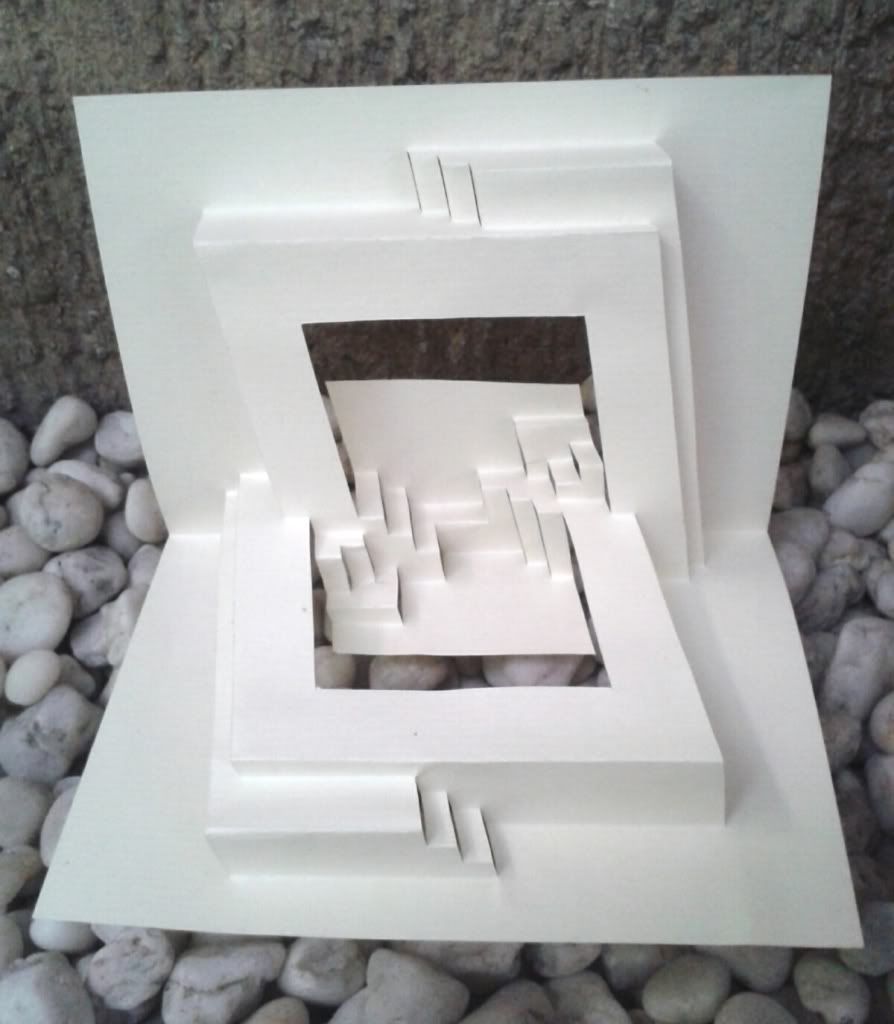
Week 24 was my first week at my new job, so I managed only to start folding units for another icosadodecahedron:
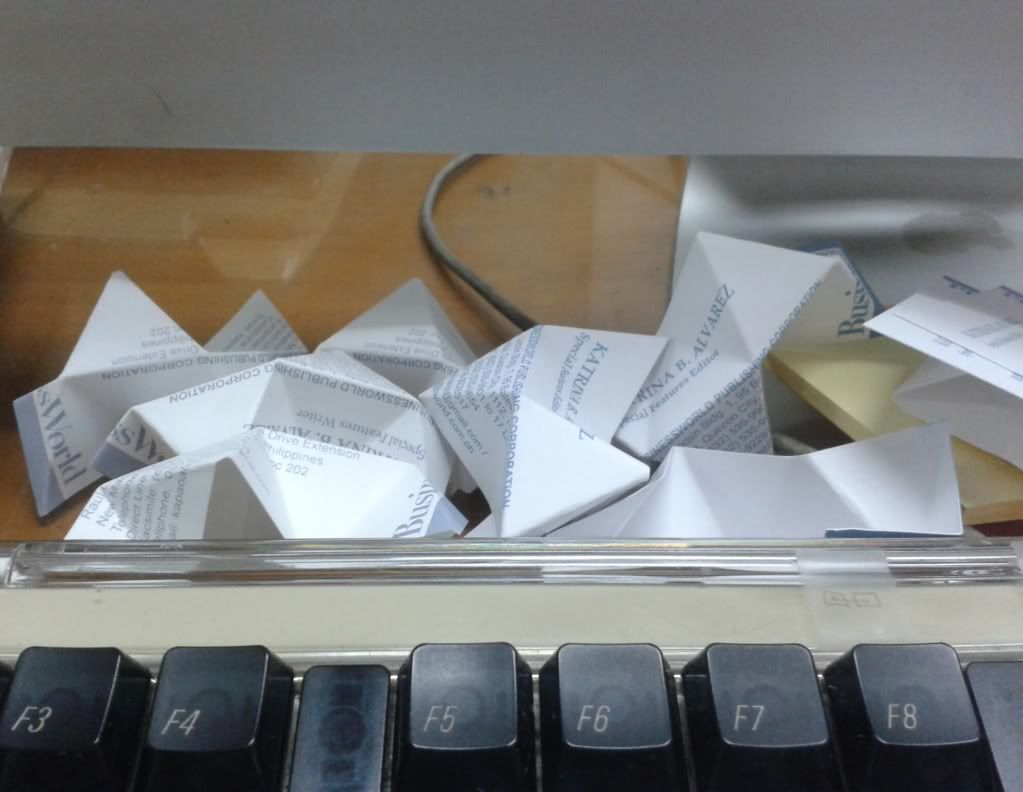
This time, half were some old editor cards, and half were some old writer cards.
I assembled it the next day, but since you already know what it would look like, I didn't take a picture of the complete model.
For week 25, I drew this background for my Processing project. This is a photo instead of a scan as, like my black paper, my scanner is in storage. :|
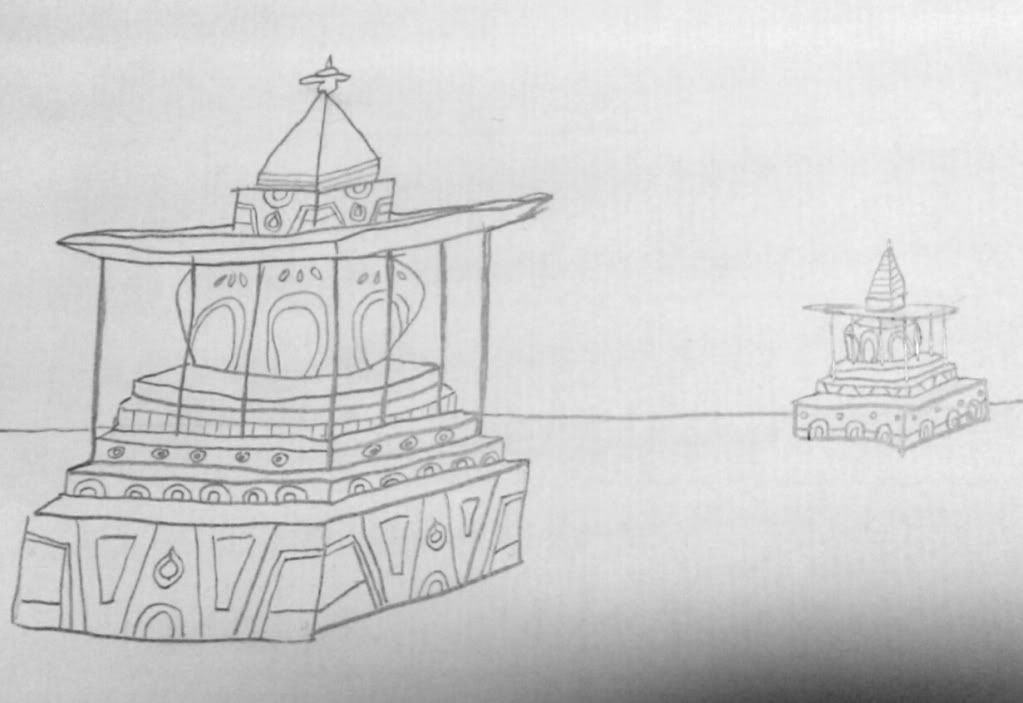
I'm a little over halfway done with this thing-a-week series, and I think this is the first time I've put up a more detailed drawing than a rough kirigami diagram. This is far from original, though, as it's largely based on a photograph by Cory Richards of the Tsarang temples in Nepal.
A little after my last post about my troubles coming up with an original story concept for my Processing project, I actually hit on something, so I guess we'll see how it turns out.
Anyway, I wanted to do something more about interiors than exteriors, and while I don't know if it's clear from this picture, I wanted to do something that wasn't all right angles.

Week 24 was my first week at my new job, so I managed only to start folding units for another icosadodecahedron:

This time, half were some old editor cards, and half were some old writer cards.
I assembled it the next day, but since you already know what it would look like, I didn't take a picture of the complete model.
For week 25, I drew this background for my Processing project. This is a photo instead of a scan as, like my black paper, my scanner is in storage. :|

I'm a little over halfway done with this thing-a-week series, and I think this is the first time I've put up a more detailed drawing than a rough kirigami diagram. This is far from original, though, as it's largely based on a photograph by Cory Richards of the Tsarang temples in Nepal.
A little after my last post about my troubles coming up with an original story concept for my Processing project, I actually hit on something, so I guess we'll see how it turns out.
19 June 2013
Letter No. 23
Started yesterday; finished today.
--
It turns out that the mid shift can be good for a morning person, or at least for people who like to spend their mornings doing nothing.
Maybe my body clock still needs to adjust to my new working hours, but despite the late nights I've had lately, I still wake up at around six AM and have trouble going back to sleep afterward.
My body has been like this since childhood. It's as if it knows that there is so much to do and so little time; whether I've had a full night's sleep or just an hour's, I have no choice but to begin another day conscious.
Now that I'm on the mid shift, this means that I have a couple extra hours every day to do whatever I want (except maybe go back to sleep, haha) instead of rushing to get ready for work. This morning, I finally got to hand-wash some laundry. I sang out loud. I did my last peer evaluations for my Python class (I can't do this during the waiting hours at work because it involves playing five different games of Asteroids). I had eggs with thyme and tortillas instead of just cereal. I played a couple songs on my ocarina and then a couple rounds of Triple Town. And after I finally did get ready for work, I still had time to experiment with a different commuting route and pick up some groceries so I wouldn't have another dinner of rice crackers.
I'm actually struggling more with meals than with sleep. Along with its own alarm clock, my body has a pretty rigid eating schedule and will punish me with hyperacidity if I don't follow. My classmates used to joke that they could tell time by my stomach.
In my new department, things are pretty quiet until the daily story conference at three PM. After that, you can expect to be hard at work until nine if you're lucky (one page, good stories) and 12 if you're not (two pages, not-as-good stories, and give or take an hour if you're Night Editor). There's no time to break for dinner because any breaks longer than the time it takes to refill your tumbler or empty your bladder mean that your pages are that much later.
I've only been here a week, though, so I'm hoping that I'll get faster; I'll know things better and have to double-check things less often, and my layouts will get less embarrassing and need less polishing by the artists.
But even if the long nights are here to stay, it's nice to know that I'll have the mornings to recover my spirit, if not my sleep.
--
Learning to play a four-hole pendant ocarina last year made me see how much I took music lessons for granted. I'd forgotten how much fun it could be to play an instrument, so I asked Cris to get me a 12-hole ocarina when he went back to China last month. It's a good-sized alto C ceramic "sweet potato", though the orange color makes it look more like a carrot. :)
I sometimes wonder how things would have been different if I hadn't stopped piano lessons, so I feel like I'm catching up a little by learning songs and looking for sheet music that doesn't have anything higher than high F or low A.
I hope the neighbors aren't tired of "Danny Boy" yet.
--
As the Python course entered its last week, instead of diving into Python on my own, I signed up for another course that involves a little design, a little music, and a little programming. It sounds perfect for me, but I'm forced to confront something I kept at the back of my mind when Python class was still in session.
I don't know what to build. Or rather, I don't know if I can come up with anything original to build.
This wasn't such a problem in Python class because each project had specific objectives: build Pong, build a Blackjack game, build Asteroids, etc. But as the course went on, I was a little alarmed that I wasn't coming up with any ideas for original games to attempt building when I was done with the class. Not even for simple toys like this elegant pendulum program by Emily Wachtel (press the play button, then mess around with the other stuff in the window that pops up). Maybe that's why I signed up for the digital media course so quickly; maybe a new class would distract me from the fact that my personal drawing board was empty.
The trouble is, this new class requires that we submit a creative project in two weeks, and I can't think of anything. We have the option to extend some of the demo programs in the class, but I find even that I challenge — not a technical challenge, but a personal one. I think I've had enough of building on templates from the Python class; I need to prove to myself that I can build something from scratch. But, what?
If I'm honest with myself, this is something I've been struggling with for a few years now. I haven't had a good fiction idea in ages. The unfinished stuff — either I've abandoned it because I've lost my connection to the story, or I'm stuck in a part of the plot and can't find my way forward.
What this has to do with programming is that I want my projects to have stories. They don't have to be as elaborate as choose-your-own-adventure games; they can be as simple as a Ferry Halim game like Pocketful of Stars or The Crossing (though I know I can't expect my graphics to be as lovely).
I could be overthinking this, of course. I probably just need to step back and scribble.
--
It turns out that the mid shift can be good for a morning person, or at least for people who like to spend their mornings doing nothing.
Maybe my body clock still needs to adjust to my new working hours, but despite the late nights I've had lately, I still wake up at around six AM and have trouble going back to sleep afterward.
My body has been like this since childhood. It's as if it knows that there is so much to do and so little time; whether I've had a full night's sleep or just an hour's, I have no choice but to begin another day conscious.
Now that I'm on the mid shift, this means that I have a couple extra hours every day to do whatever I want (except maybe go back to sleep, haha) instead of rushing to get ready for work. This morning, I finally got to hand-wash some laundry. I sang out loud. I did my last peer evaluations for my Python class (I can't do this during the waiting hours at work because it involves playing five different games of Asteroids). I had eggs with thyme and tortillas instead of just cereal. I played a couple songs on my ocarina and then a couple rounds of Triple Town. And after I finally did get ready for work, I still had time to experiment with a different commuting route and pick up some groceries so I wouldn't have another dinner of rice crackers.
I'm actually struggling more with meals than with sleep. Along with its own alarm clock, my body has a pretty rigid eating schedule and will punish me with hyperacidity if I don't follow. My classmates used to joke that they could tell time by my stomach.
In my new department, things are pretty quiet until the daily story conference at three PM. After that, you can expect to be hard at work until nine if you're lucky (one page, good stories) and 12 if you're not (two pages, not-as-good stories, and give or take an hour if you're Night Editor). There's no time to break for dinner because any breaks longer than the time it takes to refill your tumbler or empty your bladder mean that your pages are that much later.
I've only been here a week, though, so I'm hoping that I'll get faster; I'll know things better and have to double-check things less often, and my layouts will get less embarrassing and need less polishing by the artists.
But even if the long nights are here to stay, it's nice to know that I'll have the mornings to recover my spirit, if not my sleep.
--
Learning to play a four-hole pendant ocarina last year made me see how much I took music lessons for granted. I'd forgotten how much fun it could be to play an instrument, so I asked Cris to get me a 12-hole ocarina when he went back to China last month. It's a good-sized alto C ceramic "sweet potato", though the orange color makes it look more like a carrot. :)
I sometimes wonder how things would have been different if I hadn't stopped piano lessons, so I feel like I'm catching up a little by learning songs and looking for sheet music that doesn't have anything higher than high F or low A.
I hope the neighbors aren't tired of "Danny Boy" yet.
--
As the Python course entered its last week, instead of diving into Python on my own, I signed up for another course that involves a little design, a little music, and a little programming. It sounds perfect for me, but I'm forced to confront something I kept at the back of my mind when Python class was still in session.
I don't know what to build. Or rather, I don't know if I can come up with anything original to build.
This wasn't such a problem in Python class because each project had specific objectives: build Pong, build a Blackjack game, build Asteroids, etc. But as the course went on, I was a little alarmed that I wasn't coming up with any ideas for original games to attempt building when I was done with the class. Not even for simple toys like this elegant pendulum program by Emily Wachtel (press the play button, then mess around with the other stuff in the window that pops up). Maybe that's why I signed up for the digital media course so quickly; maybe a new class would distract me from the fact that my personal drawing board was empty.
The trouble is, this new class requires that we submit a creative project in two weeks, and I can't think of anything. We have the option to extend some of the demo programs in the class, but I find even that I challenge — not a technical challenge, but a personal one. I think I've had enough of building on templates from the Python class; I need to prove to myself that I can build something from scratch. But, what?
If I'm honest with myself, this is something I've been struggling with for a few years now. I haven't had a good fiction idea in ages. The unfinished stuff — either I've abandoned it because I've lost my connection to the story, or I'm stuck in a part of the plot and can't find my way forward.
What this has to do with programming is that I want my projects to have stories. They don't have to be as elaborate as choose-your-own-adventure games; they can be as simple as a Ferry Halim game like Pocketful of Stars or The Crossing (though I know I can't expect my graphics to be as lovely).
I could be overthinking this, of course. I probably just need to step back and scribble.
05 June 2013
Letter No. 22
Next week, I'll be leaving Special Features for a spot in the Editorial department, so tonight, I'm treating the writers to dinner at one of our favorite restaurants nearby. It's not so much a goodbye as, "I'll just be down the hall."
I've kept this under my hat for a while, partly because I was waiting for the official announcement at work, and partly because I still haven't really worked out how I feel about the transfer. It was my decision. Everyone says it's a good career decision. People are giving me their congratulations. Still, it's going to be something new, and a new thing for someone who has been doing the same kind of work for four years is scary. No wonder people with 10- or 20-year careers at one job go nuts.
Also, thinking about leaving Special Features feels like a door closing, maybe even another childhood ending. Mikko asked me about it over lunch one Sunday, and I somehow came up with, "I like who I've become since college, and I did a lot of that becoming in Special Features."
Sometime between last year and the year I joined BusinessWorld, I stopped seeing my life as a sad city story. I started to believe I could be good at being alive. Going to work every day stopped being a drag. I was learning and making new things. I had made my peace with the city. I was coming to terms with who I was to my family, and who they were to me. And, I had found a love better than anything I'd imagined for myself.
Somewhere along the way, the meaning of growing up changed. It isn't no longer getting to be the child you were. It's keeping that child happy while teaching her to not be childish when life gets scary and unfair. It's seeing yourself at 5, 10, 16 years old and being able to say, I am still that person, but I am more that person today than ever. It's being able to recognize yourself more clearly with every year.
My high school science teacher told us in freshman year that people are like pots. Life molds and fires them, and they're set by the time you reach 20-something.
I've come to think of people as a certain kind of place. In certain places, trees will grow, be cut down, or die; buildings will come up and fall down; people will move in, move out, be born, live, and die; and grass will grow, be paved over, and grow again, but the places are unmistakably still those places. It's sort of the same starfish recovery I had in mind when I started this blog, but less about moving on through suffering, with a little more lingering on the suffering than necessary, and more about just being yourself.
The day I realized this "certain place" thing about Kalsangi was the day I stopped worrying that it would somehow stop being my home. The day I realized that my family was the same way was the day I stopped worrying about change. It wasn't long before the day I realized that about myself. The more my life changes, the more clearly I see my own shape. And the day I can no longer see Kalsangi, my family, myself, or Cris under whatever surfaces we've assumed will surely be the saddest day ever.
However hard it got, working in Special Features was part of a process. It was especially hard in the beginning, but it helped me to grow up, which is to say that it helped me see that growing up did not mean what I thought it meant. I saw that I could find an anchor point in myself as long as I could see where I fit in the world, if I wanted to. And at a particularly low point in my life, when everything else suddenly went to shit, working here kept me from dissolving into someone I wouldn't be able to recognize.
To those of you who've worked with me, thanks for being part of that — and for putting up with me when I got absent-minded or weird.
I guess it's all this that's going to see me through whatever's waiting for me down the hall.
I've kept this under my hat for a while, partly because I was waiting for the official announcement at work, and partly because I still haven't really worked out how I feel about the transfer. It was my decision. Everyone says it's a good career decision. People are giving me their congratulations. Still, it's going to be something new, and a new thing for someone who has been doing the same kind of work for four years is scary. No wonder people with 10- or 20-year careers at one job go nuts.
Also, thinking about leaving Special Features feels like a door closing, maybe even another childhood ending. Mikko asked me about it over lunch one Sunday, and I somehow came up with, "I like who I've become since college, and I did a lot of that becoming in Special Features."
Sometime between last year and the year I joined BusinessWorld, I stopped seeing my life as a sad city story. I started to believe I could be good at being alive. Going to work every day stopped being a drag. I was learning and making new things. I had made my peace with the city. I was coming to terms with who I was to my family, and who they were to me. And, I had found a love better than anything I'd imagined for myself.
Somewhere along the way, the meaning of growing up changed. It isn't no longer getting to be the child you were. It's keeping that child happy while teaching her to not be childish when life gets scary and unfair. It's seeing yourself at 5, 10, 16 years old and being able to say, I am still that person, but I am more that person today than ever. It's being able to recognize yourself more clearly with every year.
My high school science teacher told us in freshman year that people are like pots. Life molds and fires them, and they're set by the time you reach 20-something.
I've come to think of people as a certain kind of place. In certain places, trees will grow, be cut down, or die; buildings will come up and fall down; people will move in, move out, be born, live, and die; and grass will grow, be paved over, and grow again, but the places are unmistakably still those places. It's sort of the same starfish recovery I had in mind when I started this blog, but less about moving on through suffering, with a little more lingering on the suffering than necessary, and more about just being yourself.
The day I realized this "certain place" thing about Kalsangi was the day I stopped worrying that it would somehow stop being my home. The day I realized that my family was the same way was the day I stopped worrying about change. It wasn't long before the day I realized that about myself. The more my life changes, the more clearly I see my own shape. And the day I can no longer see Kalsangi, my family, myself, or Cris under whatever surfaces we've assumed will surely be the saddest day ever.
However hard it got, working in Special Features was part of a process. It was especially hard in the beginning, but it helped me to grow up, which is to say that it helped me see that growing up did not mean what I thought it meant. I saw that I could find an anchor point in myself as long as I could see where I fit in the world, if I wanted to. And at a particularly low point in my life, when everything else suddenly went to shit, working here kept me from dissolving into someone I wouldn't be able to recognize.
To those of you who've worked with me, thanks for being part of that — and for putting up with me when I got absent-minded or weird.
I guess it's all this that's going to see me through whatever's waiting for me down the hall.
29 May 2013
thing-a-week 20, 21, 22: macrame, sketches, Liana's birthday card + bonus origami vandalism
Week 20 saw me really busy, packing and moving out of my apartment. I had to stow my craft supplies for a while, but I managed to hang on to this bit of blue cloth, which I used to make another macrame bracelet.
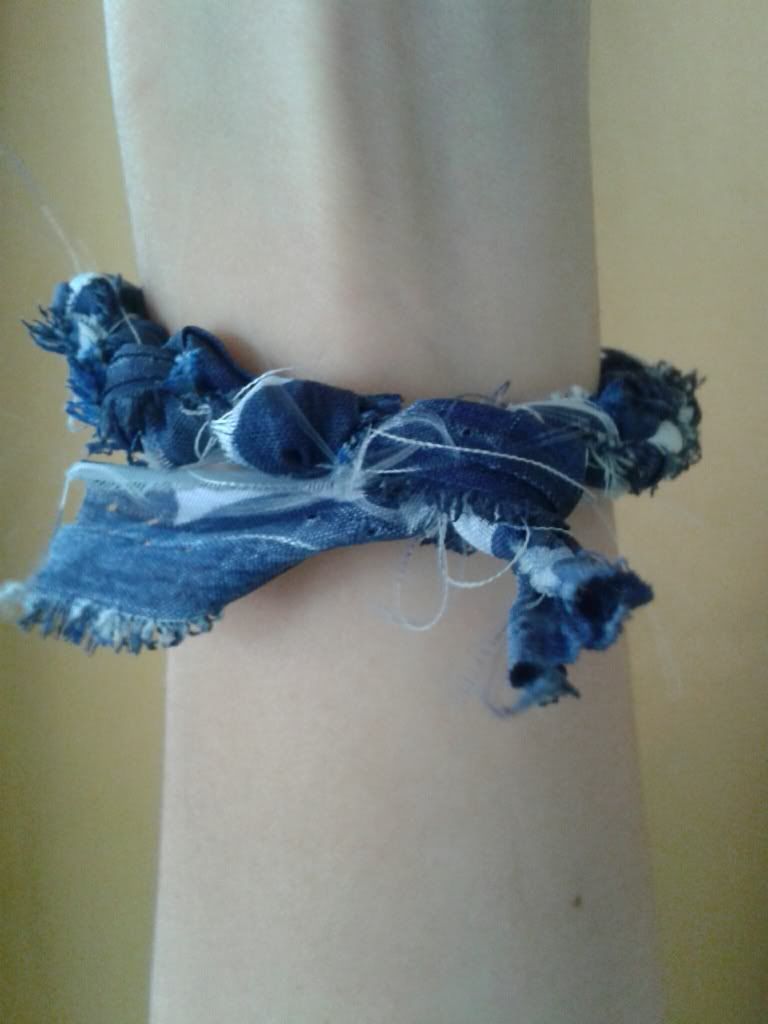
It looks like any other rag, but it happens to be symbolic to me. The original length of cloth was used to tie up the new mattress I got from an outlet store, just a few weeks after I first moved into the apartment and maybe a month or so into my relationship with Cris. I remember feeling pretty grateful that day, that I could afford a little lifestyle upgrade and that I had someone like Cris to help me, even if he didn't have to. Physically and symbolically, the mattress was a nice step up from the old, sunken one I'd borrowed from my grandmother when I'd first moved into an apartment, now five years ago.
I also used a bit of the cloth in designing the cover of a journal that I completed in the apartment. Consider the fact that I hung on to the cloth for so long as proof of howbig a hoarder I am sentimental I can be. (I still have a little more!)
Week 21 was difficult; the apartment I'm moving into next isn't actually finished yet, so I'm staying with friends for now. I made these sketches of kirigami models to illustrate verses from "The Black Riders and Other Lines," by Stephen Crane. But, the longer commute to and from my friends' place means less time to draft, cut, and fold models these days, so the sketches had to do for last week. I also couldn't find my craft knife; I should have set it aside during the move.
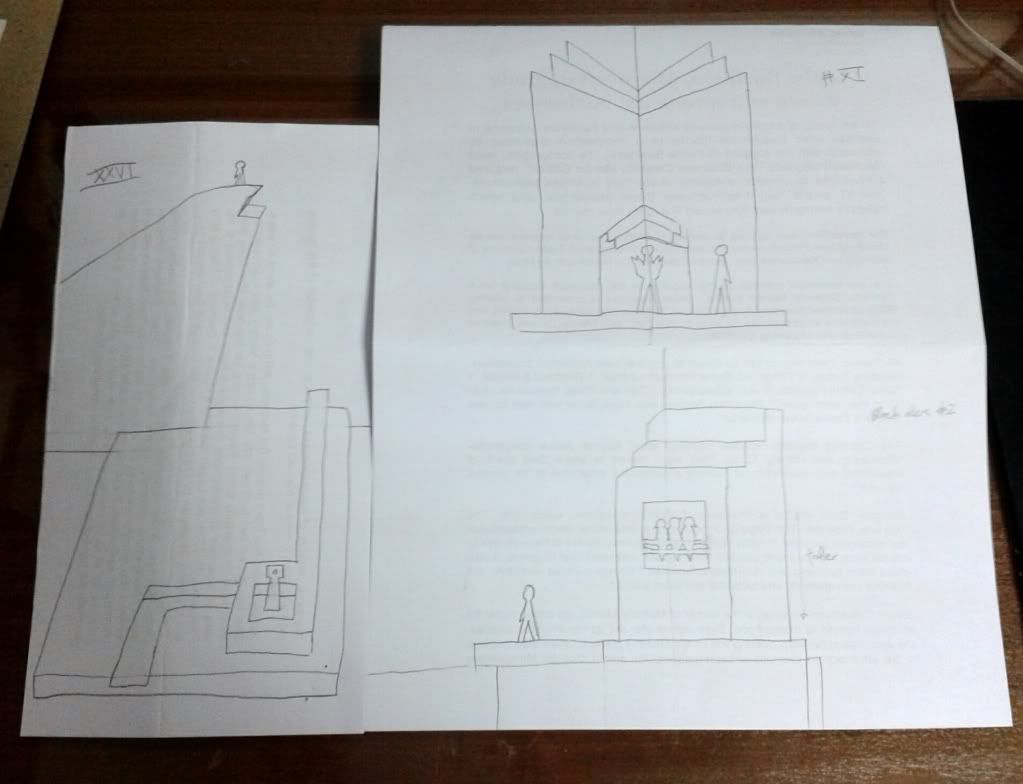
Today is my officemate Liana's birthday, so I made her this card. Liana loves dogs, and her family lost their beloved yellow labrador, Charlie, sometime ago. It looks like a lhasa apso puppy will be joining them this year, though.
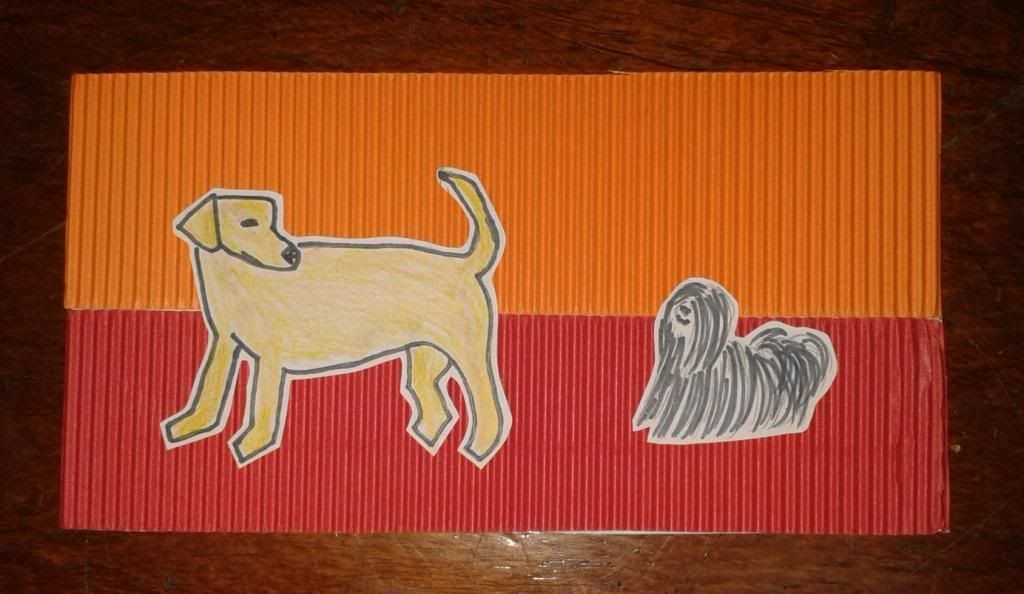
To make up for the weeks I posted sketches, I learned a new modular origami unit that uses business cards instead of square papers.
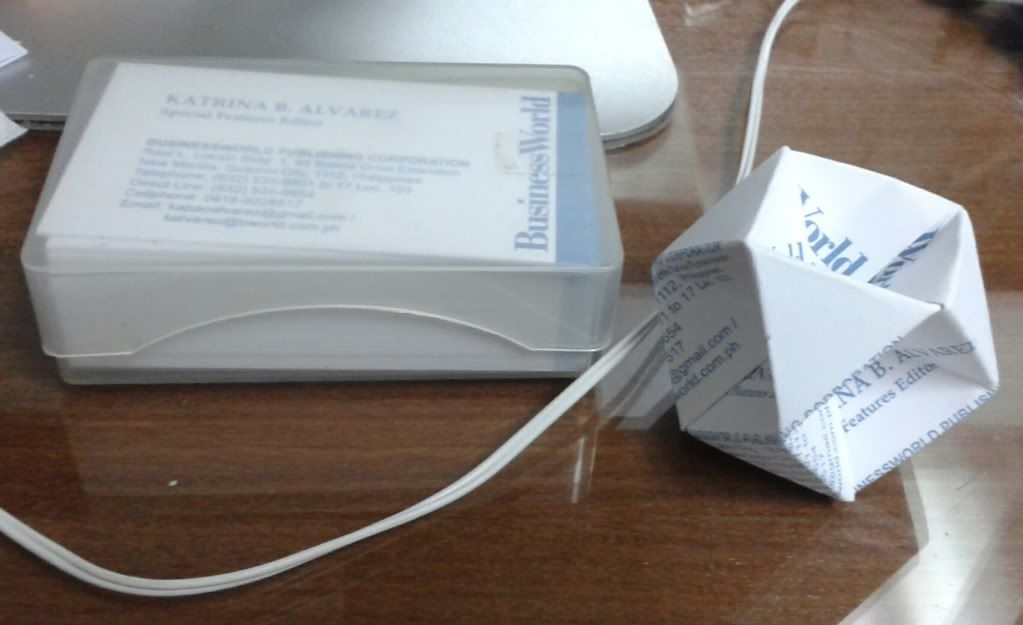
I also learned that people in the origami community (!) can be pretty protective of models they claim to have discovered first, and because I learned the folds from Malachi Brown's website, I might be considered an origami vandal. (If you like, you can click on that link, and we can be vandals together.)
In grade school, I first learned origami from older kids who had books and who most definitely did not write to the authors of those books to ask permission to teach other kids how to fold the different models. All this time, I've experienced origami as a fun kind of geometry — everyone can learn geometry; there's no law against teaching each other math that happens to make flapping birds and inflatable paper balloons that inevitably get soaked with saliva at the blowhole.
I can understand how you might want something you've discovered all on your own to stay your own, but I don't see Pythagoras's estate chasing down everyone who wants to calculate the distance between two points, or Einstein's lawyers filing claims against every last t-shirt with E = m * c ** 2 on it.
But, okay, for the sake of attribution, an origami person (folder? craftsperson? artisan? artist?) named Valerie Vann claims to have discovered the base unit for the models I'm showing here. I did this for fun, not for profit.
Here are three hassocks, so called because they're cushion-shaped, and an icosadodecahedron. Oddly enough, I couldn't figure out how to make the pentagon hassock until I'd figured out the icosadodecahedron. There is also an octahedron in the back that uses a unit by Jennifer Campbell, but based on Mr. Brown's website, she doesn't seem as possessive of her discovery.
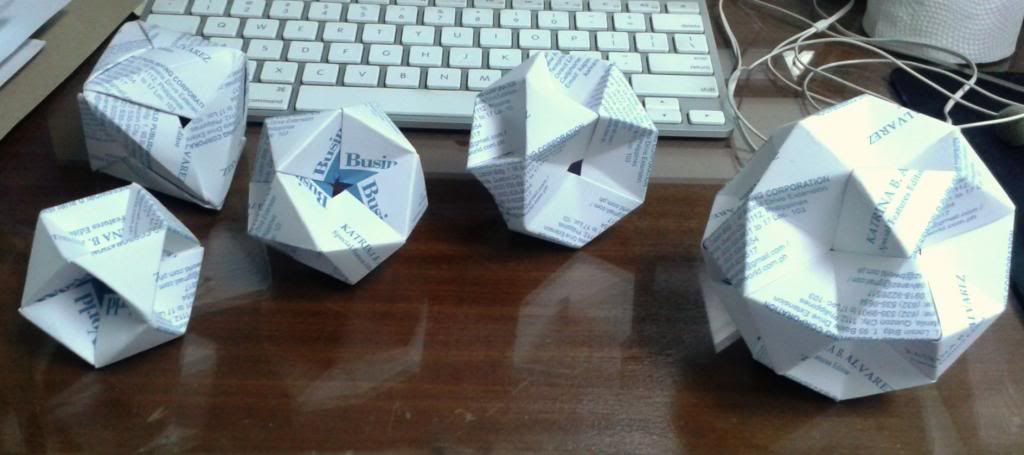
Perhaps this is a waste of business cards, but you'll have to take it up with the people who make them in such big batches. I didn't give out half of these before they became outdated.

It looks like any other rag, but it happens to be symbolic to me. The original length of cloth was used to tie up the new mattress I got from an outlet store, just a few weeks after I first moved into the apartment and maybe a month or so into my relationship with Cris. I remember feeling pretty grateful that day, that I could afford a little lifestyle upgrade and that I had someone like Cris to help me, even if he didn't have to. Physically and symbolically, the mattress was a nice step up from the old, sunken one I'd borrowed from my grandmother when I'd first moved into an apartment, now five years ago.
I also used a bit of the cloth in designing the cover of a journal that I completed in the apartment. Consider the fact that I hung on to the cloth for so long as proof of how
Week 21 was difficult; the apartment I'm moving into next isn't actually finished yet, so I'm staying with friends for now. I made these sketches of kirigami models to illustrate verses from "The Black Riders and Other Lines," by Stephen Crane. But, the longer commute to and from my friends' place means less time to draft, cut, and fold models these days, so the sketches had to do for last week. I also couldn't find my craft knife; I should have set it aside during the move.

Today is my officemate Liana's birthday, so I made her this card. Liana loves dogs, and her family lost their beloved yellow labrador, Charlie, sometime ago. It looks like a lhasa apso puppy will be joining them this year, though.

To make up for the weeks I posted sketches, I learned a new modular origami unit that uses business cards instead of square papers.

I also learned that people in the origami community (!) can be pretty protective of models they claim to have discovered first, and because I learned the folds from Malachi Brown's website, I might be considered an origami vandal. (If you like, you can click on that link, and we can be vandals together.)
In grade school, I first learned origami from older kids who had books and who most definitely did not write to the authors of those books to ask permission to teach other kids how to fold the different models. All this time, I've experienced origami as a fun kind of geometry — everyone can learn geometry; there's no law against teaching each other math that happens to make flapping birds and inflatable paper balloons that inevitably get soaked with saliva at the blowhole.
I can understand how you might want something you've discovered all on your own to stay your own, but I don't see Pythagoras's estate chasing down everyone who wants to calculate the distance between two points, or Einstein's lawyers filing claims against every last t-shirt with E = m * c ** 2 on it.
But, okay, for the sake of attribution, an origami person (folder? craftsperson? artisan? artist?) named Valerie Vann claims to have discovered the base unit for the models I'm showing here. I did this for fun, not for profit.
Here are three hassocks, so called because they're cushion-shaped, and an icosadodecahedron. Oddly enough, I couldn't figure out how to make the pentagon hassock until I'd figured out the icosadodecahedron. There is also an octahedron in the back that uses a unit by Jennifer Campbell, but based on Mr. Brown's website, she doesn't seem as possessive of her discovery.

Perhaps this is a waste of business cards, but you'll have to take it up with the people who make them in such big batches. I didn't give out half of these before they became outdated.
15 May 2013
Letter No. 21
Obviously, I haven't made time to blog in the past couple of weeks. Work was especially busy, and when I wasn't working, I was studying, working on a craft, hanging out with Cris, or just letting my brain rest. So, all in all, I've been busy in a good way.
I can't seem to let too much time pass without documenting some of it, though.
I'm moving out of my current apartment soon. It's a pity; the fire trees in the village park below my window are abloom again. My next window will be closer to the ground. It overlooks a narrow street and faces the side of a Korean church. At least it's yellow, and they have a few trees.
No hard feelings about having to move, though. It wasn't actually long into my lease that I saw, my lovely apartment was little more than an expensive locker in a great location. Yes, I lived there, and I was happy there with my crafts and my books and my simple home cooking and the way the sun turned my cheap curtains into spun gold. But I spent so much of the year living — really living! — outside, too. This year promises even more.
So, it just makes sense to find a cheaper place nearer work, so I spend less time on the road, less money on storage, and more time just living.
Sometimes, I can't believe how much things have changed in the past year-and-a-half. I like who I've been becoming. I like where my life seems to be going. I like most of the people who surround me these days, and my dislike for the rest has at least scaled down to general indifference. ("Do you have a problem in your life?") Life is good.
I'm enjoying language learning more than ever. I'm in intermediate Chinese now, and, all humility aside, I'm doing pretty well. I've also enrolled in a free python MOOC on a whim, partly to see what a MOOC was like, and partly to see if I could still learn to code something other than the minimum blogging requires.
Whether I'm learning human or computer language, there's something really rewarding about understanding how language parts goes together. Chinese is sort of mathematical, musical, symbolic, and poetic (the Chinese for "guest" — the same "guest" you see in the word for "hotel" — is a component of the word for "Philippines"). Python programming is creating math and logic puzzles that then solve themselves. All in all, I think I'm putting up a decent resistance against what a University of Virginia study says is an inevitable decline in brain power when you hit 27.
Things I do miss: China and Glitch. Last month, I was sort of offered a return trip to China, but the sort-of-i-ness means I don't know whether I'll still get to go. Cris was in Guangzhou for two weeks (he'll be flying in tonight), and the pictures he sent me reminded me of how much fun it was to explore. As for Glitch, well, I still haven't found a diversion as wonderfully weird as a place where dinosaur colon was a mode of transportation.
I can't seem to let too much time pass without documenting some of it, though.
I'm moving out of my current apartment soon. It's a pity; the fire trees in the village park below my window are abloom again. My next window will be closer to the ground. It overlooks a narrow street and faces the side of a Korean church. At least it's yellow, and they have a few trees.
No hard feelings about having to move, though. It wasn't actually long into my lease that I saw, my lovely apartment was little more than an expensive locker in a great location. Yes, I lived there, and I was happy there with my crafts and my books and my simple home cooking and the way the sun turned my cheap curtains into spun gold. But I spent so much of the year living — really living! — outside, too. This year promises even more.
So, it just makes sense to find a cheaper place nearer work, so I spend less time on the road, less money on storage, and more time just living.
Sometimes, I can't believe how much things have changed in the past year-and-a-half. I like who I've been becoming. I like where my life seems to be going. I like most of the people who surround me these days, and my dislike for the rest has at least scaled down to general indifference. ("Do you have a problem in your life?") Life is good.
I'm enjoying language learning more than ever. I'm in intermediate Chinese now, and, all humility aside, I'm doing pretty well. I've also enrolled in a free python MOOC on a whim, partly to see what a MOOC was like, and partly to see if I could still learn to code something other than the minimum blogging requires.
Whether I'm learning human or computer language, there's something really rewarding about understanding how language parts goes together. Chinese is sort of mathematical, musical, symbolic, and poetic (the Chinese for "guest" — the same "guest" you see in the word for "hotel" — is a component of the word for "Philippines"). Python programming is creating math and logic puzzles that then solve themselves. All in all, I think I'm putting up a decent resistance against what a University of Virginia study says is an inevitable decline in brain power when you hit 27.
Things I do miss: China and Glitch. Last month, I was sort of offered a return trip to China, but the sort-of-i-ness means I don't know whether I'll still get to go. Cris was in Guangzhou for two weeks (he'll be flying in tonight), and the pictures he sent me reminded me of how much fun it was to explore. As for Glitch, well, I still haven't found a diversion as wonderfully weird as a place where dinosaur colon was a mode of transportation.
11 May 2013
thing-a-week 17, 18, and 19
Things have been really busy in the past couple of weeks, but I've done my best to keep up with the crafts.
When I started making kirigami, I went through an inverted symmetry phase, and I wanted to revisit it for Week 17. Unfortunately, work piled up that week, so all I have to show for it is this nearly done diagram. I had a bit of a problem with the middle chunk, so I decided to start over.
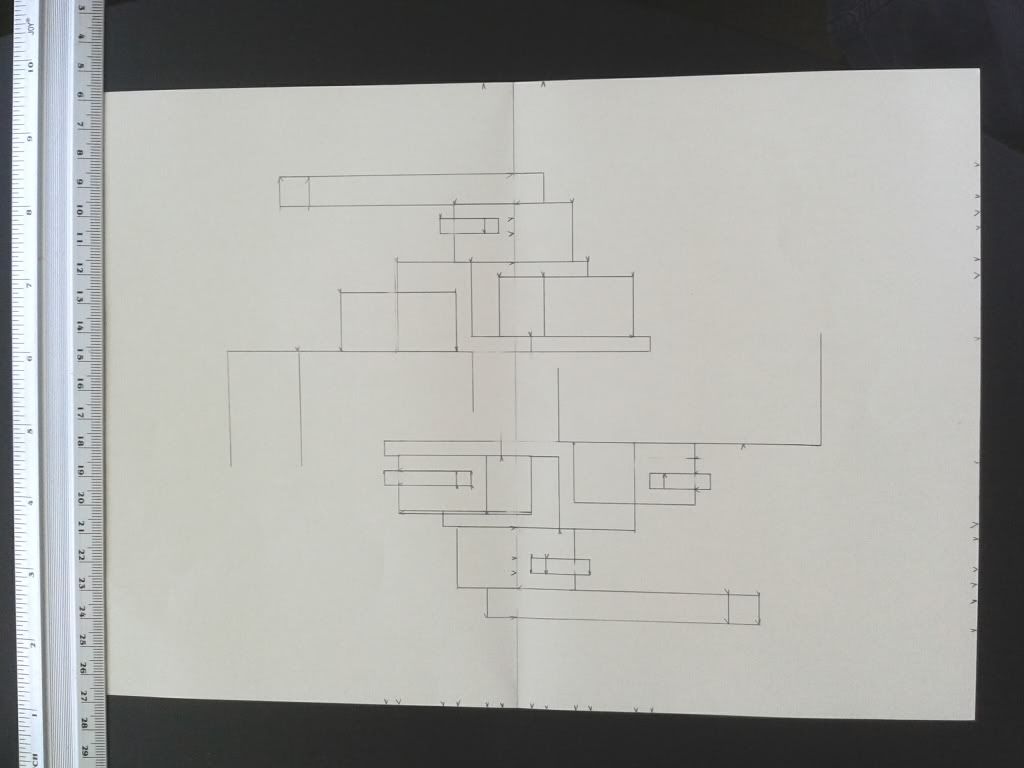
Week 18 was not much better, but I lucked out when Taiwan put on a big tourism exhibit in the new Glorietta activity center, where they gave free supplies for these cows and messages in bottles. Mine is the blue cow; Mikko's is the gray.

They came courtesy of Flying Cow Ranch, the "Most Childish Ranch in Western Taiwan." The brochure offers other wonderful Engrish gems; this is what's on the cover:
Flying Cow Ranch is natural and fun,
Because the ranch is built by our bared hands and feet.
In Flying Cow Ranch,
You can jump like a child,
You can laugh like a child,
You can drink some milk with children.
The ranch is filled with the rich smell of dairy products.
Come to visit the most childish ranch in Taiwan.
And have great fun here!
To be honest, I really want to go now, but that's because I like farms in general.
Week 19, this past week, was a lot better. I went through with my inverted symmetry. I was initially inspired by the cover of "North," by Stars, but I was also thinking of cities in outer space and the squarish scrollwork around some Chinese windows and building accents.
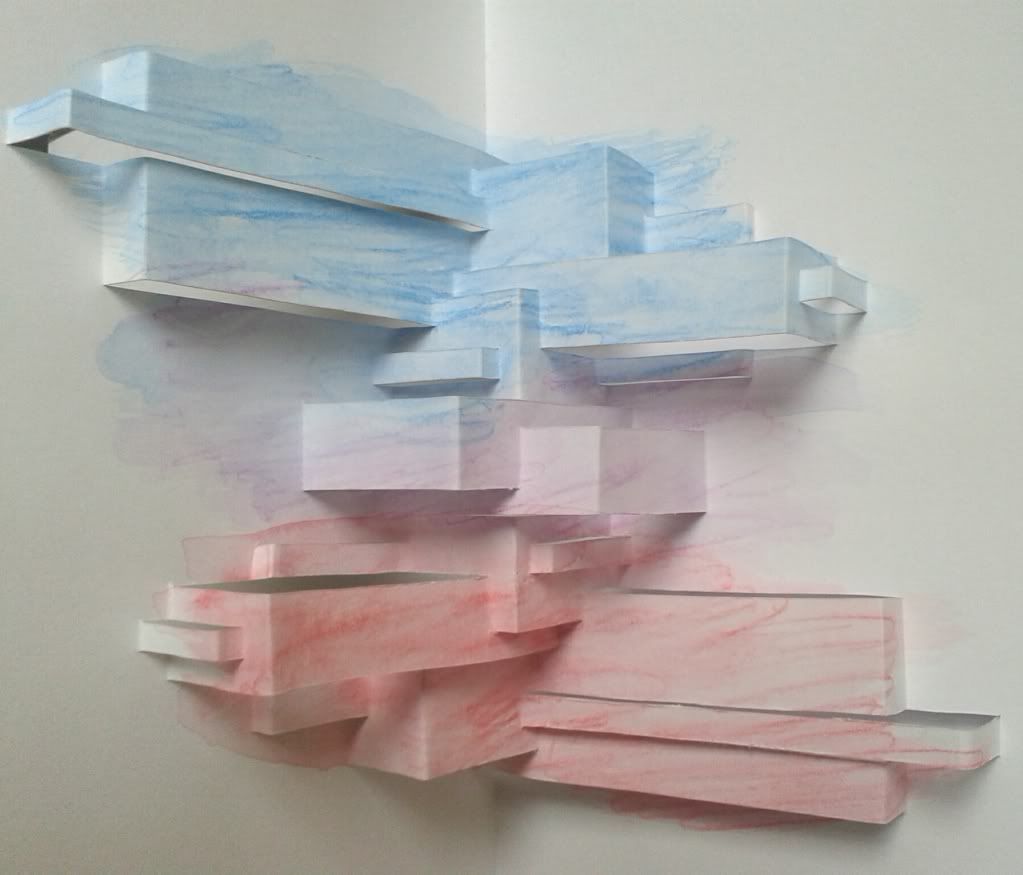

When I started making kirigami, I went through an inverted symmetry phase, and I wanted to revisit it for Week 17. Unfortunately, work piled up that week, so all I have to show for it is this nearly done diagram. I had a bit of a problem with the middle chunk, so I decided to start over.

Week 18 was not much better, but I lucked out when Taiwan put on a big tourism exhibit in the new Glorietta activity center, where they gave free supplies for these cows and messages in bottles. Mine is the blue cow; Mikko's is the gray.

They came courtesy of Flying Cow Ranch, the "Most Childish Ranch in Western Taiwan." The brochure offers other wonderful Engrish gems; this is what's on the cover:
Flying Cow Ranch is natural and fun,
Because the ranch is built by our bared hands and feet.
In Flying Cow Ranch,
You can jump like a child,
You can laugh like a child,
You can drink some milk with children.
The ranch is filled with the rich smell of dairy products.
Come to visit the most childish ranch in Taiwan.
And have great fun here!
To be honest, I really want to go now, but that's because I like farms in general.
Week 19, this past week, was a lot better. I went through with my inverted symmetry. I was initially inspired by the cover of "North," by Stars, but I was also thinking of cities in outer space and the squarish scrollwork around some Chinese windows and building accents.


27 April 2013
Letter No. 20
I have a striped green, black, and white dress with pockets that I like to wear only occasionally, when it's a particularly special day, when I want a little confidence boost, or when I have a meeting with a client on whom I want to make certain impressions: "I'm professional enough to dress well, but young enough to avoid anything resembling your suit."
I don't have a lot of clothes, so maybe that makes it easy for me to remember which shirt or dress I wore on a particularly memorable day. For instance, I can remember that the shirt I wore yesterday is also the shirt I was wearing when Cris first asked me out. It's also the shirt I was wearing two years ago, when my former boss told me that she was leaving, and I was going to take over (like I said, I don't have a lot of clothes).
I wore my striped dress the other day, on one of the longest working days I've had in a while. Something bad happened at work, it was nobody's fault*, but because I was the one who had to make the required emergency request, I felt burnt down. While heading out to meet Cris and smother my fatigue with Chickenjoy, I remembered that it was also the dress I wore on the day I described in this blog entry, which sounds like whining about Makati rush hour but really came from the middle of being burned down by everything at once.
I wondered idly if my dress could be cursed. But, I quickly remembered that I also wore this dress on my birthday last year, on one of the most magical days I've ever had.
Last year, after the last big fire, I also reacted differently. I wanted to leave my job and possibly even leave the country. This year, I just wanted to get some fried chicken and gravy and then go home.
Maybe it's because I was actually near home, and sitting in my office instead of slogging through torrential rain like last year. But for better or for worse, I've learned to care less.
There is only so much you can do when you're trying to do your job, and only so much you can control when, while you're a boss of some sort, you're not the boss of the unpredictable, unreliable factors and non-coworkers on which your team's final output depends. I've learned to set my jaw and just make sure no one can say we're not doing our job, even as everything around us is, well, on fire. And sure, I've made a few mistakes here and there, but nothing so disastrous as to merit punishment other than the mental beating I give myself. Nobody's perfect, and when you're juggling all kinds of demands, you're bound to drop something.
Maybe it sounds careless, but it's a result of having learned to care less. At some point, getting worked up about what's gone wrong is just beating a dead horse. There's a handy little diagram that I saw floating around the Internet a long time ago, and I printed it out and stuck it on our office door, right under a souvenir from a former colleague:
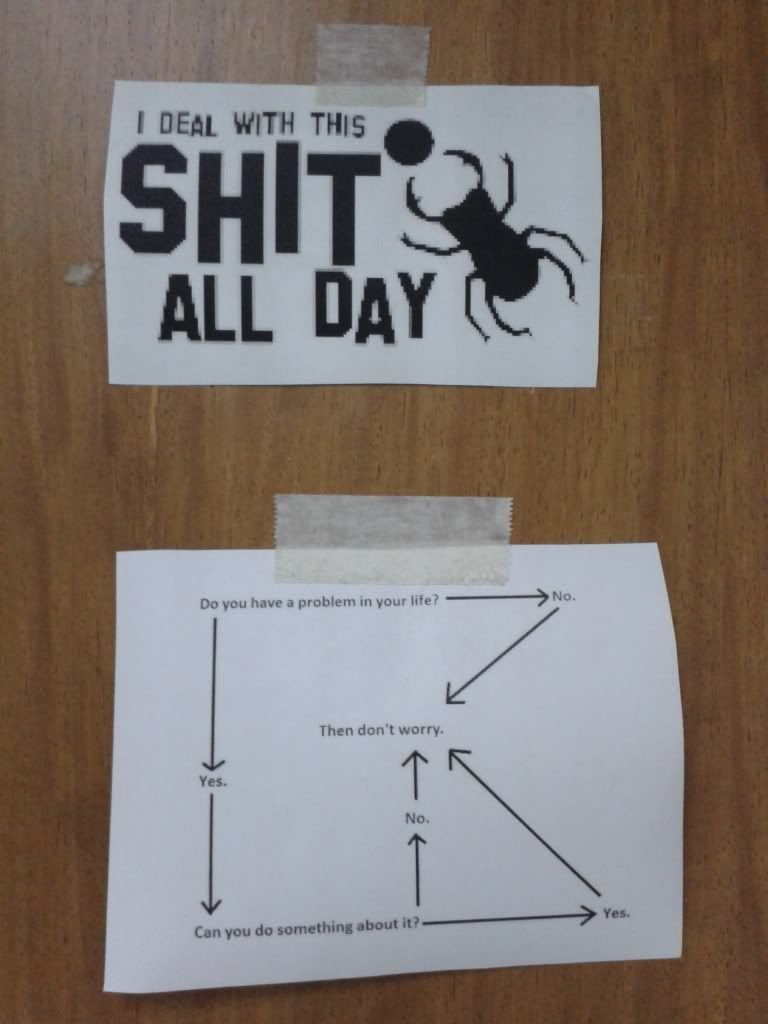
Over time, I've taken this to heart. You do what you can do about a problem, and then you don't worry about it anymore. It's kept me from losing my shit completely, especially on days like yesterday, which was even worse than the day before.
The people we couldn't blame* kept us at the office, fighting fires, till around 10 at night. I hung around waiting for Cris outside. For the first time, I was the last person on the newspaper staff to leave the building. Even the senior editors had gone home hours before our team did. The guard turned the lights out after I went outside. The wind blew cold and hard, and I played games on my phone. Then, Cris arrived, we got KFC drive-thru, and he drove me home.
It's no use letting some bad juju ruin a favorite shirt, or a perfectly good dress.
--
* It really was somebody's fault, but they got to wear the immunity necklace and could not be voted off the island.
I don't have a lot of clothes, so maybe that makes it easy for me to remember which shirt or dress I wore on a particularly memorable day. For instance, I can remember that the shirt I wore yesterday is also the shirt I was wearing when Cris first asked me out. It's also the shirt I was wearing two years ago, when my former boss told me that she was leaving, and I was going to take over (like I said, I don't have a lot of clothes).
I wore my striped dress the other day, on one of the longest working days I've had in a while. Something bad happened at work, it was nobody's fault*, but because I was the one who had to make the required emergency request, I felt burnt down. While heading out to meet Cris and smother my fatigue with Chickenjoy, I remembered that it was also the dress I wore on the day I described in this blog entry, which sounds like whining about Makati rush hour but really came from the middle of being burned down by everything at once.
I wondered idly if my dress could be cursed. But, I quickly remembered that I also wore this dress on my birthday last year, on one of the most magical days I've ever had.
Last year, after the last big fire, I also reacted differently. I wanted to leave my job and possibly even leave the country. This year, I just wanted to get some fried chicken and gravy and then go home.
Maybe it's because I was actually near home, and sitting in my office instead of slogging through torrential rain like last year. But for better or for worse, I've learned to care less.
There is only so much you can do when you're trying to do your job, and only so much you can control when, while you're a boss of some sort, you're not the boss of the unpredictable, unreliable factors and non-coworkers on which your team's final output depends. I've learned to set my jaw and just make sure no one can say we're not doing our job, even as everything around us is, well, on fire. And sure, I've made a few mistakes here and there, but nothing so disastrous as to merit punishment other than the mental beating I give myself. Nobody's perfect, and when you're juggling all kinds of demands, you're bound to drop something.
Maybe it sounds careless, but it's a result of having learned to care less. At some point, getting worked up about what's gone wrong is just beating a dead horse. There's a handy little diagram that I saw floating around the Internet a long time ago, and I printed it out and stuck it on our office door, right under a souvenir from a former colleague:

Over time, I've taken this to heart. You do what you can do about a problem, and then you don't worry about it anymore. It's kept me from losing my shit completely, especially on days like yesterday, which was even worse than the day before.
The people we couldn't blame* kept us at the office, fighting fires, till around 10 at night. I hung around waiting for Cris outside. For the first time, I was the last person on the newspaper staff to leave the building. Even the senior editors had gone home hours before our team did. The guard turned the lights out after I went outside. The wind blew cold and hard, and I played games on my phone. Then, Cris arrived, we got KFC drive-thru, and he drove me home.
It's no use letting some bad juju ruin a favorite shirt, or a perfectly good dress.
--
* It really was somebody's fault, but they got to wear the immunity necklace and could not be voted off the island.
22 April 2013
thing-a-week 16: tunnel book
This is my first attempt at a tunnel book. It was my original plan for part of an anniversary gift, but I went with something else instead. :) I'm not going to share photos of that, though, so you get this tunnel book.
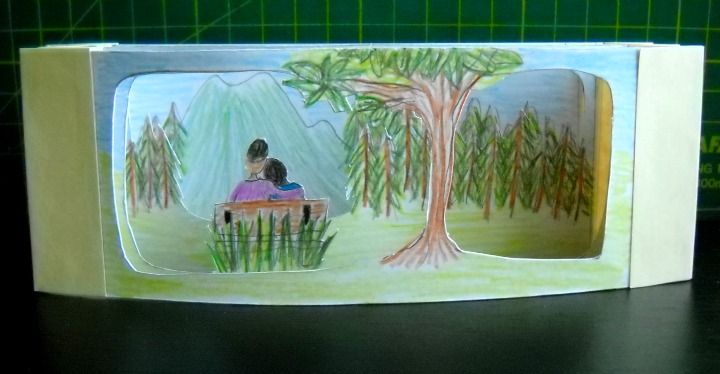
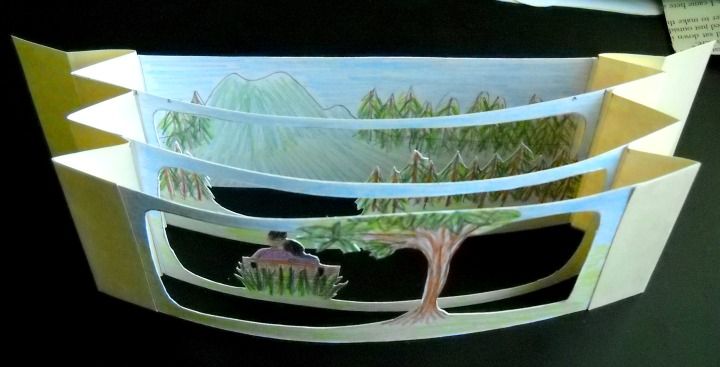
The top-view photo is actually older; you can see in the front-view photo that the flaps in the back have been cut off.
Tunnel books can be flattened for storage. Some of them have cover flaps — which I guess is why they're called "books", but I opted to leave this open. You can read more about tunnel books on Wikipedia.
The scene, for those of you who may not be familiar with the place, is inspired by the Kalsangi golf course and its view of Mt. Matutum.


The top-view photo is actually older; you can see in the front-view photo that the flaps in the back have been cut off.
Tunnel books can be flattened for storage. Some of them have cover flaps — which I guess is why they're called "books", but I opted to leave this open. You can read more about tunnel books on Wikipedia.
The scene, for those of you who may not be familiar with the place, is inspired by the Kalsangi golf course and its view of Mt. Matutum.
18 April 2013
Leavings 041813
These are just some things I've been thinking about; you can read through the whole thing or just skip to the parts you're interested in.
1. Through the Deep, Dark Valley, by The Oh Hello's
Annoying apostrophe aside, The Oh Hello's show promise on this debut album. I chanced upon it on NoiseTrade, a pay-what-you-what website, but it's also available on the band's own website.
The bible geek in me got a really big kick out of all the references in the lyrics — there's some Psalm 23 and post-Exodus Hebrew frustration, some Adam and Eve angst, and a prodigal son narrative in there, for instance — but it's nothing like any contemporary Christian music I've heard. I haven't seen any interview or post in which the band makes some statement of faith, anyway. The only obvious clue is "I Was Wrong," whose first line is, "I was born at the hands of the potter." But these songs about love, wandering, and forgiveness could apply to any other relationship, not just one's relationship with their God.
The best songs are open to interpretation. For instance, my favorite, "Like the Dawn," could very well be about Adam's discovery of Eve, but it could also be about a relationship that may or may not be doomed. In "In Memoriam", the mention of God, which the band capitalizes on its website, could tell you that the song is addressed to God, but it could also just be a passing mention in a song to a faithful lover or friend.
Foreign critics say that the US is having a folk music revival, so I guess The Oh Hello's hope to be part of that. Listeners might thus be quick to dismiss the band as copycats of the Kings of Leon or Mumford & Sons, especially on the songs with male vocalist Taylor in the lead. However, I hope you stay for the stronger songs, the ones where female vocalist Maggie is the star. It's not just because I'm female myself or because her voice has a lovely drawl, but also because those songs happen to be lyrically stronger.
I think the album could have done without "I Have Made Mistakes" entirely; it seems redundant right after "I Was Wrong." One exception to my Maggie-songs-are-better kick, though, is "The Lament of Eustace Scrubb"; Taylor's subdued voice conveys the plight of this Narnia character very effectively, while the lyrics don't give the whole story away.
2. "The Carrie Diaries" and wish fulfillment
I've never seen "The Sex and the City", but I like its prequel series, "The Carrie Diaries", whose first season just finished. I think many of the characters' actions and reactions in recent episodes are wish fulfillment, but I don't care. If young girls get their ideas about sex and relationships from the culture they consume, then I hope they're consuming this, because the lessons from this show could save teenage girls from a lot of pain.
a. Don't put up with shitty double standards for males and females.
b. If you think a relationship is getting in the way of getting good grades and/or being true to yourself, maybe it's time to revalue that relationship.
c. Great boyfriends don't pressure you into doing anything you don't feel ready for.
d. Overthinking things can ruin friendships and relationships.
e. When you screw up, don't make excuses or create unnecessary drama; just apologize.
f. Sex is not love, but if you're not one of those people who can detach themselves so thoroughly, it's better for you to do it with someone you love.
g. Parents are people, too — but they shouldn't dump their drama on you or use you as a go-between when their relationships are on the rocks.
3. Diverse casting
Another thing I like about "The Carrie Diaries" is its diverse casting: Ellen Wong (Jill "Mouse" Chen) is Chinese, Katie Findlay (Maggie) is part-Chinese, RJ Brown (Thomas West) is African-American, and Freema Agyeman (Larissa Loughlin) has Iranian and Ghanaian parents. Also, Chloe Bridges (Donna LaDonna) may have Hispanic roots; her real surname is Suazo, and she played a lot of Hispanic characters before playing Donna LaDonna. (I read a lot of Wikipedia, okay?) I think they just need to even up the number of POC males/boyfriends; there's only one, and he's with Mouse, the only other teenage character clearly identified as a POC.
Diverse casting and representation is something I've taken an interest in since the racebending debacle that was "The Last Airbender". It's nice when casting directors recognize that POCs don't have to play stereotypical roles, when they don't whitewash POC characters in the source material so they can cast the current hot young white actor, and when writers realize that characters can be changed to accommodate more POCs in a dominantly white cast. For instance, Mouse in the "Carrie Diaries" source novel isn't actually Asian, but casting Ellen Wong shows that you can have POC characters who are just as capable and valuable.
It's also nice when they incorporate a POC/biracial actor's roots into the story. Larissa Loughlin could just have been a fabulous black British lady, but her back story includes escaping an oppressive adolescence in Ghana. Kristin Kreuk, another part-Asian actress, commonly plays white characters, but in her current series, "Beauty in the Beast", her character Catherine is biracial, with an also biracial younger sister (played by part-Filipino Nicole Anderson) and a clearly Asian mother.
Actually, "Beauty and the Beast" also has a laudably diverse cast. Not only is the lead biracial, but the police chief is black, Catherine's partner Tess is Hispanic, and the new assistant district attorney is South Asian. It's nice to see POCs written as complete human beings instead of stereotypes, and it's even nicer to see POCs in positions of authority and power.
It's also nice when American shows recognize that POCs are Americans, too, not outsiders just trying to blend in. So, while movies like the "Red Dawn" remake and "Olympus Has Fallen" show whites as the heroes and POCs as inferior and/or untrustworthy — if not as the antagonists, plain and simple — "Beauty and the Beast" shows that POCs can be good citizens who live to protect the innocent and uphold the law of their [new] homeland. Catherine's mother appears only in a few flashback scenes, but it's important to note that she's portrayed as a good-hearted military scientist who wants to defend her country.
The best part is that nobody's view of the characters is obscured by their racial or ethnic backgrounds; the audience doesn't see an all-caps look-at-this BLACK police chief, but a capable, solid police chief who just happens to be black. The only time someone notices a character's race is when some jerk refers to Tess as "Diversity Barbie", but it never happens again and is clearly taken as offensive.
I'm just sad that "Beauty and the Beast" has pretty mediocre writing; I want the show to succeed if only for what it achieves through its cast.
I'm not the one to break down all the good things about diverse casting, though; a lot of this stuff I came to appreciate by reading Racebending.com. I can only add that while casting in American media doesn't seem relevant to Filipino pop culture, I'd still like to see the day when teleseryes don't use blackface, when brown or dark actors and actresses can play leads (who are not oppressed yayas or ignorant indigenous people), when Chinese Filipinos on the screen don't all have thick accents and care only about who will inherit the family business, when characters from Visayas and Mindanao don't just serve as comic relief with "funny" accents, and when casting in general favors other Filipino actors as much it does half-white actors. Throw in some good, original writing, and hey, maybe I'll start watching local TV, too.
15 April 2013
12 April 2013
thing-a-week 15: Eush and Vikki's birthday cards
There sure have been a lot of birthdays around here.
These amateurish thaumatropes were my cards for former co-workers Eush and Vikki. I was supposed to see them Monday for a reunion/birthday dinner, but work kept me late at the office. Oh, well.
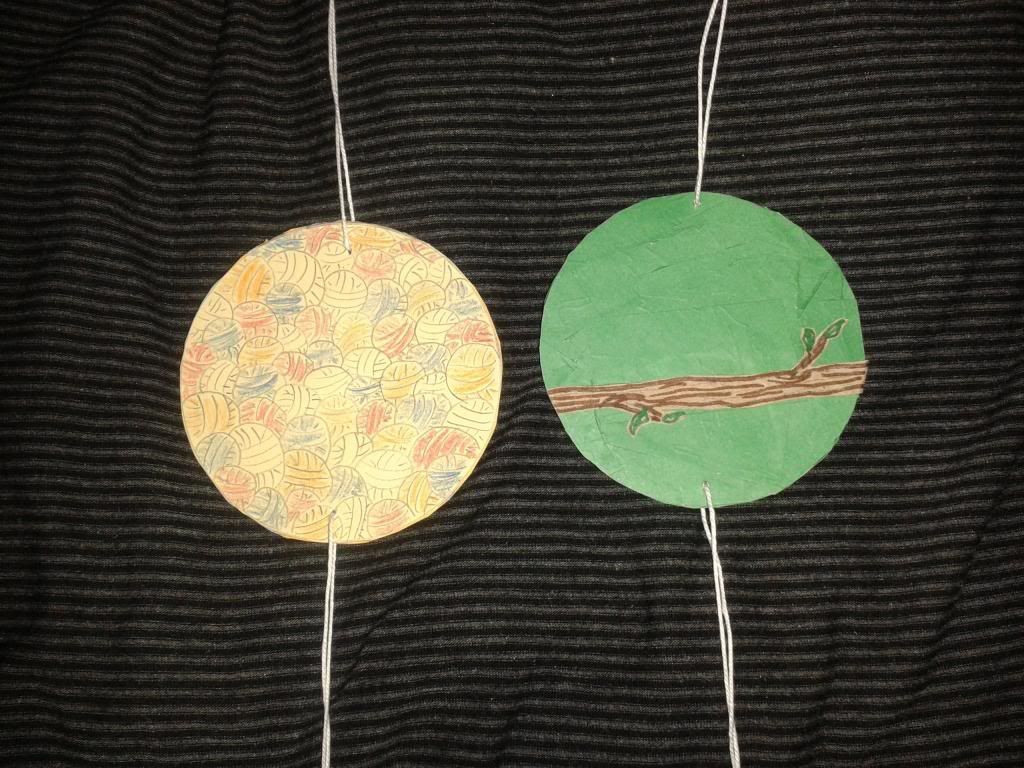

These amateurish thaumatropes were my cards for former co-workers Eush and Vikki. I was supposed to see them Monday for a reunion/birthday dinner, but work kept me late at the office. Oh, well.


I will probably redo Vikki's, because thaumatropes are supposed to have the same background on both sides.
Subscribe to:
Comments (Atom)
